 Empire of Japan, 1920. Light Cruisers:
Empire of Japan, 1920. Light Cruisers: IJN Nagara, Isuzu, Natori, Yura, Kinu, Abukuma
WW2 IJN Cruisers:
Furutaka class | Aoba class | Nachi class | Takao class | Mogami class | Tone classTenryu class | Kuma class | Nagara class | Sendai class | Katori class | Agano class | Oyodo
Tsushima | Asama | Tokiwa | Yakumo | Izumo | Kasuga | Hirado
The second “three piper” light cruiser serie
The six Nagara-class light cruisers (長良型軽巡洋艦, Nagaragata keijun’yōkan) of the Imperial Japanese Navy were part of the massive 1919 naval plan. They followed the previous Kuma class, being almost repeats with little changes. They made the backbone of the cruiser force in the 1920s and proved still useful in combat despite their age, soldierng on secondary fronts like the the Aleutians, but also the Indian Ocean. They most often served as flagships for destroyer/submarine squadrons, a role for which they had been designed originally. They were also often deployed for transport, or local defense but by 1944-45 their limited size and topwight tolerances prevented extending their AA defense and surviving ships went to assume second-line missions. The Nagara class was itself followed by the very close Sendai class, the last of this “flotilla leader” 1919 generation inugurated by the Tenryu class.
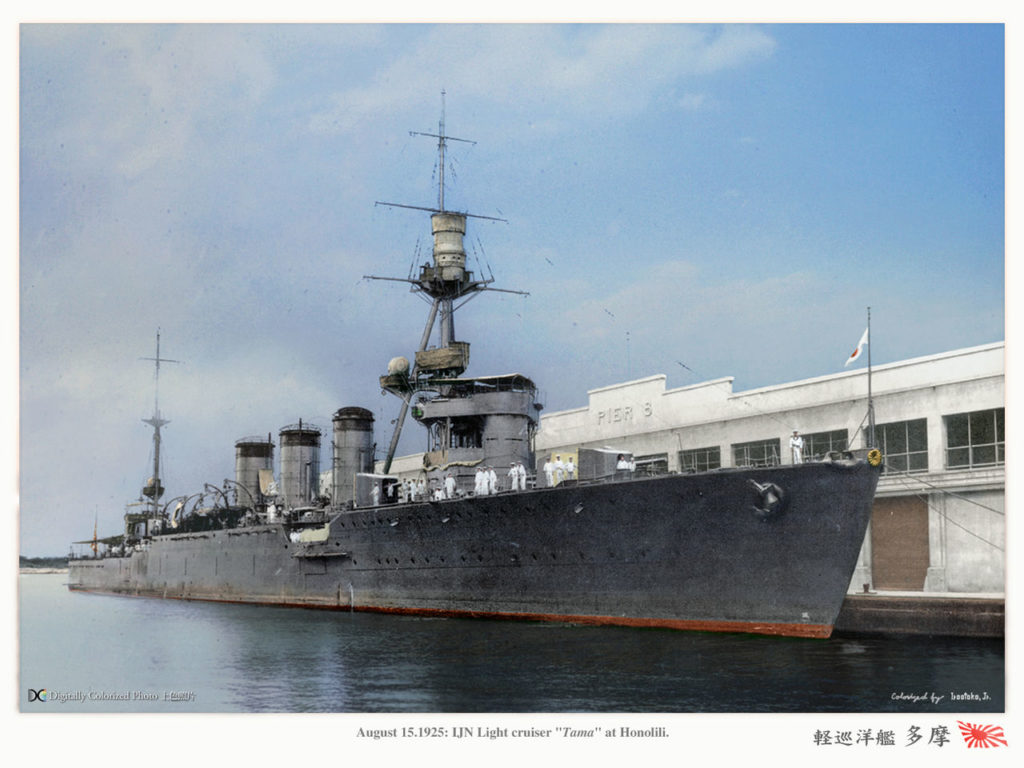
IJN Tama of the Kuma class in 1925 at Honolulu’s Pier 8, which inspired the Nagara class. Notice the early bridge, reminiscent of the previous Tenryu class.
Specifications
The Nagara class cruisers displaced 5,570 long tons (5,659 t) normal (7,203 t deep load) for 158.6 m (520 ft 4 in) at the waterline and 162.1 m (531 ft 10 in) long overall, a 14.2 m (46 ft 7 in) beam, 4.8 m (15 ft 9 in) draft. They were all propelled by the same arrangement of 4 shaft Gihon geared turbines, fed by 12 Kampon boilers for a total output rated at 90,000 shp (67,000 kW). This enables them a stop speed of 36 knots (41 mph; 67 km/h), and a range of 6,000 nmi (11,000 km) at 14 knots (26 km/h).
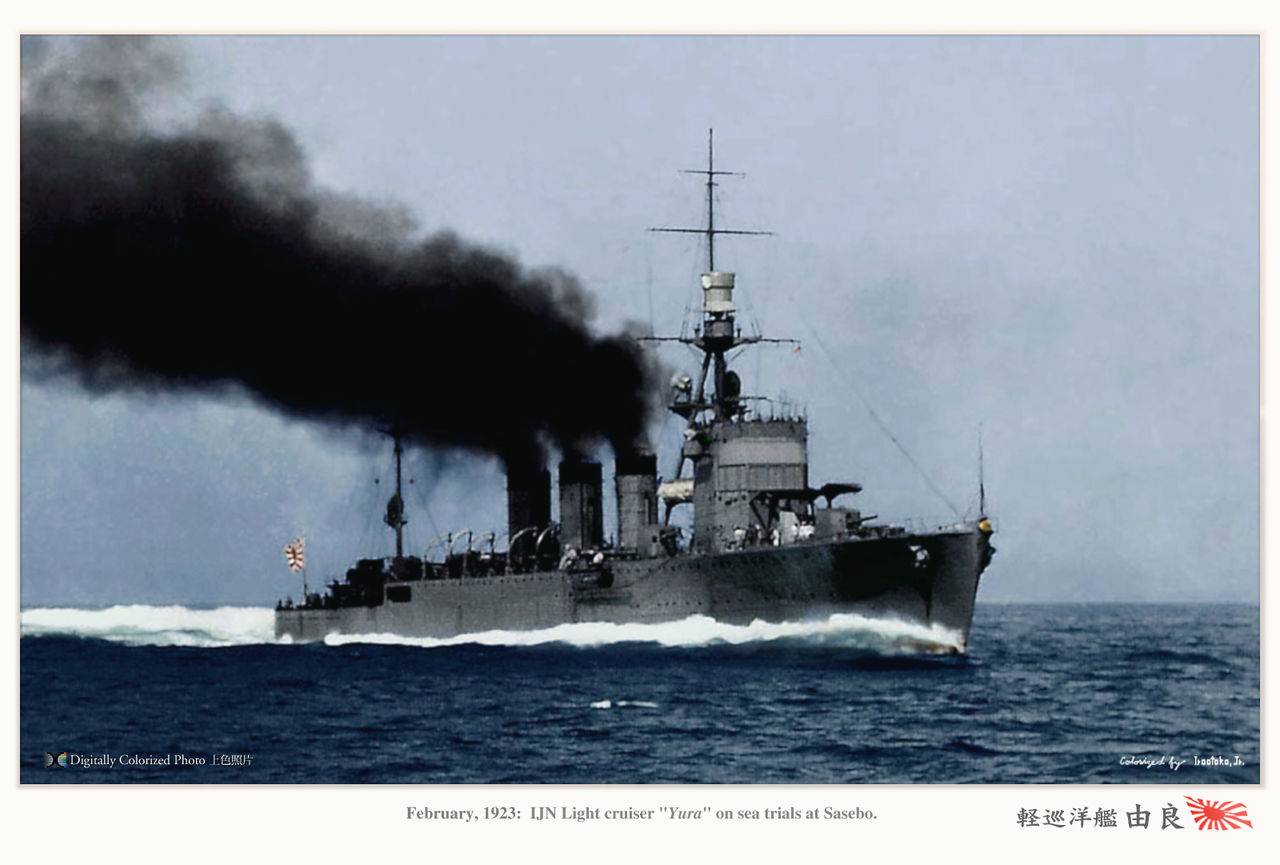
With a complement of 450 officers and ratings, they were armed by seven 14 cm/50 3rd Year Type naval guns, two 2 × 8 cm/40 3rd Year Type naval gun and eight 610 mm (24 in) torpedo tubes in four twin broadside baks. They were also fitted with rails to carry and drop 48 naval mines. They also carried an unprotected floatplane, launched at their aft axial catapult.
Protection was minimal: They were given an armoured belt 60 mm (2.4 in) in thickness for the central section (between the two aftermost guns), and an armoured deck 30 mm (1.2 in) thick.
In 1944, the rebuilt Isuzu had three twin 12.7 cm/40 Type 89 naval gun, 11 triple, and 17 single Type 96 25 mm AA guns, and depth charges. The other surviving cruisers in 1944 also received single, twin and triple 25 mm guns but mostly retained their main artillery. None was ever fitted with a radar.
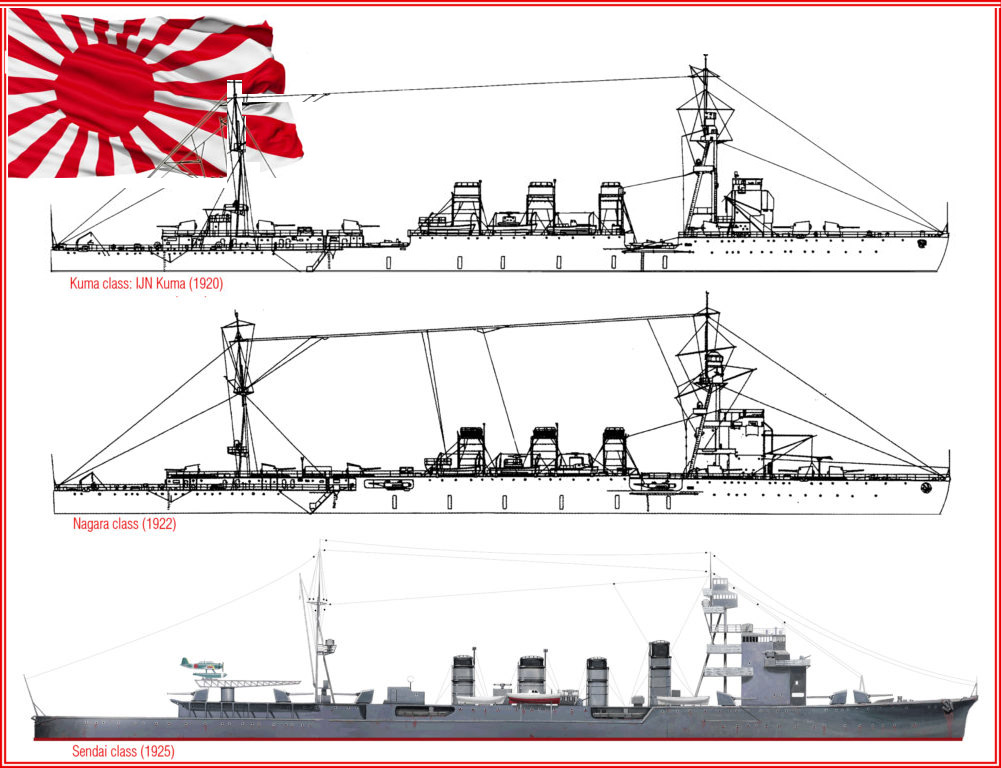
Comparison between the three classes: Kuma, Nagara and Sendai.
Design
The Nagara class were still based on the standardized 5,500 ton displacement of the Kuma class and stayed relatively similar in general conception. From dimensions and performance they were near-sister ships, with the same artillery management and calibers, but at least upgraded their torpedo tubes outfit by swapping on the new formidable 610-millimetre (24 in) Type 93 Long Lance Torpedo. They required a larger launcher (see later).
Another major difference was the bridge’s aircraft hangar accomodations, with an initially designed 33-foot (10 m) platform mounted above the No.2 turret, extending over the forward superstructure, below the bridge. Later during their first refit, this was abandoned and replaced by a standard aircraft catapult. Still in service, these arrangements proved unwieldy, and the catapult was eventually installed aft, between the last funnel and aft mast between during their reconstructions of 1929-1934. The Nagara’s bridges differed from one ship to another, some being bulky and rectangular, others lighter and triangular in shape. Abukuma mounted a 20-foot (6.1 m) rangefinder on top of her bridge instead of the tripod, Nagara and Isuzu had a 15-foot (4.6 m) one, Natori a 13-foot (4.0 m) one and Yura, Kinu a 12-foot (3.7 m) instrument on top of the bridge.
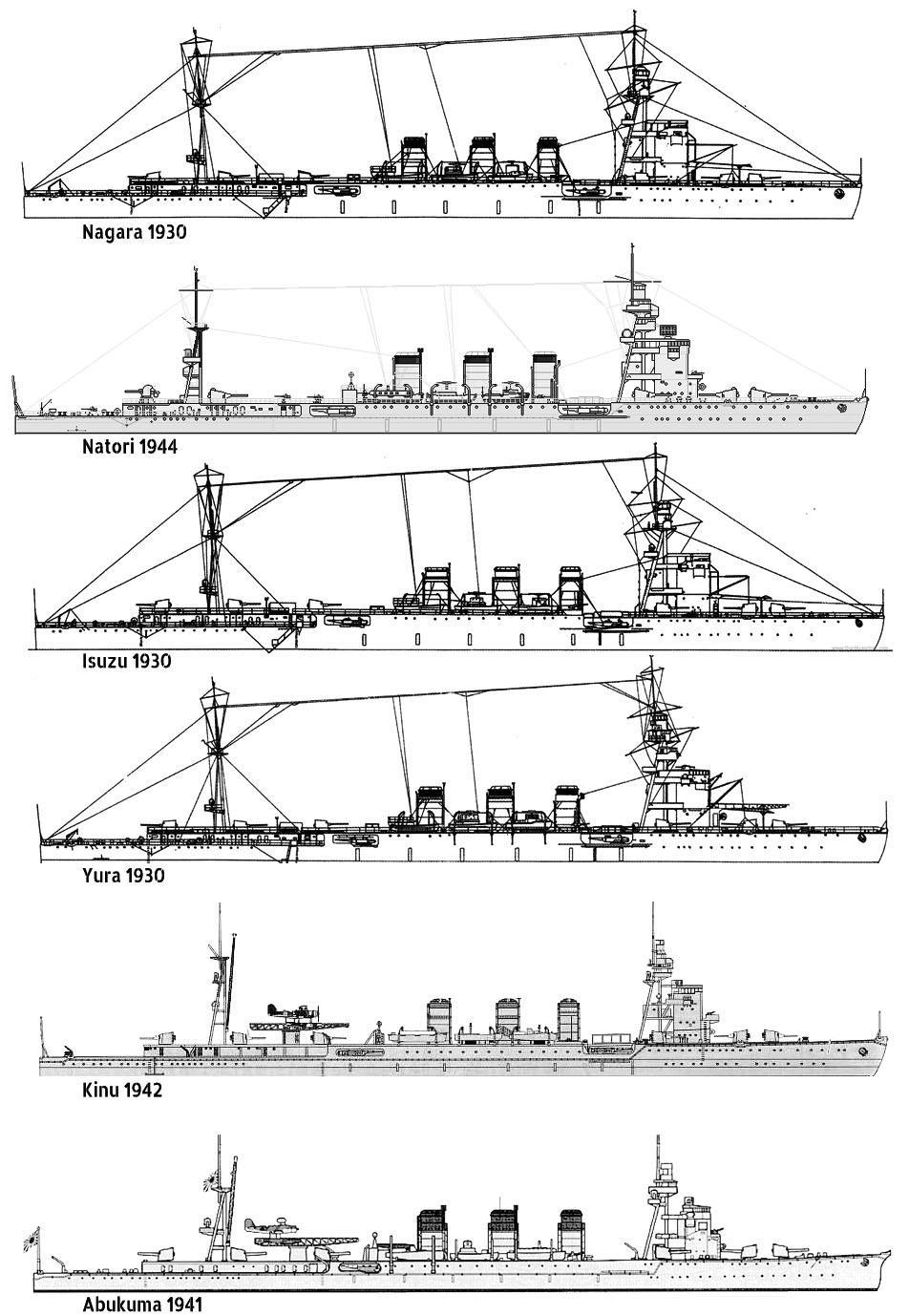
Design variations between ships in 1941
Construction and details
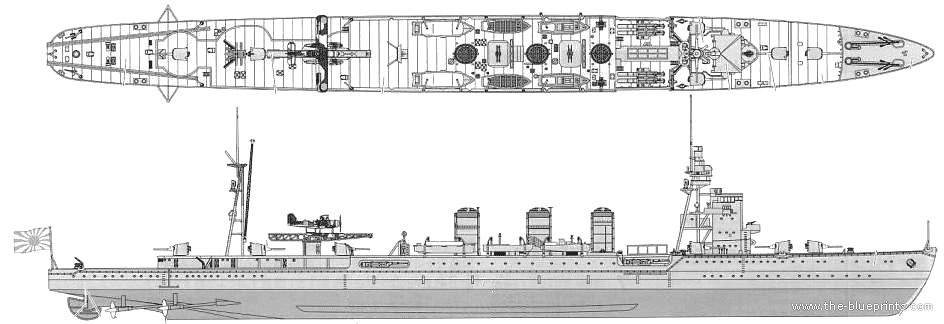
IJN Kinu in 1942
The same basic design for the hull was used, with a forecaste extending to after the third funnel, about 1/3 of the total lenght, and two underdeck openings for the torpedo tubes banks. All main armament, seven standard guns, were mostly axial, but with two wings shielded guns forward. Their silhouette was kept the same, with a tall bridge and tripod mainmast, than aft tripod supporting searchlights. The prow was given the same caracteristic “icebreaker” bow design.
The powerplant, its arrangement and locations were also identical. There was a high freeboard and relatively light bridge structure. It was the tripod that supported the main fire control platform and forward searchlights, as in the Kuma. As the Kumas, light, partly bolted construction meant their structural weakness later needed to be adressed later in the 1930s, by stiffering the hull and outer bracing.
Protection & armour scheme
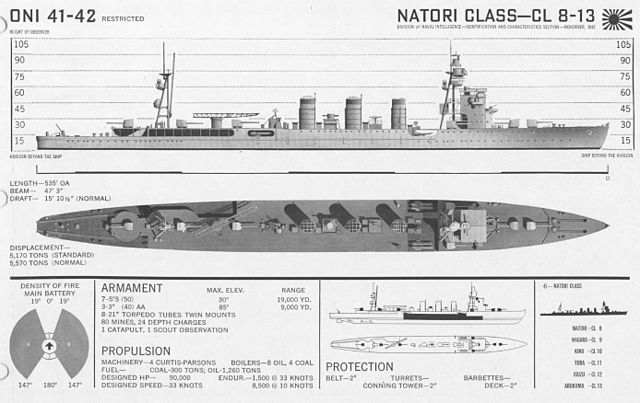
IJN Natori, ONI plate
Protection in general was the poor child of the design, and in no way innovative, as it was essentially a copy-paste of Kuma’s. Lowest in priorities, it was only provided to cover vital parts of the ship against 4 or 5 inches destroyer rounds: The armored Belt was 60 mm (2.4 in), covering the ship’s amidship section, internally. It extended from the first funnel to the aft tripod mast. This main belt was 7.32m high (24 ft) but protected only the machinery as its upper part which measured 73.2 meters long (240 ft) by 3 meters in height (10 ft), was 51mm thick. Its lower section extended on 68.3 meters (224 ft) and was 4.32 meters high (14 ft), 63mm thick (2.4 in).
The central section was enclosed in a 30 mm (1.2 in) armored deck, sloped to connect to the belt. Main guns armored shields were just thick enough to manage shrapnels. The conning tower forward was protected however by 2-inches of armour (51 mm on Kuma), with a 25 mm thick roof.
Powerplant
Propulsion system on the Nagara class used the same arrangement as Kuma’s four Curtis-Parsons axial deceleration turbines, mated with 12 mixed boilers for a total output of 90,000 hp (67,000 kW), which was exceptional in 1922. Ten boilers burned heavy oil, and two burned coal (For ONI, 8 oil, 4 coal), but the latter had injectors to spread oil and boost combustion. The Nagara-class managed to reach 36 knots (67 km/h; 41 mph), which was still very fast for a cruiser at the time. Their range, thanks to oil, was still of 9,000 nautical miles (17,000 km) at 10 knots cruising speed. She carried 1260 tons of oil and 300 tons of coal, and was still able to ru for 1,500 nautical miles at 33 knots as shown on trials.
Armament
Main battery:
Seven 14 cm/50 3rd Year Type naval guns in gun mounts with masks: Two forward in the axis, two on the wings, three aft of the funnels, including two forwrad of the aft mast, one after, in surelevated position on the quartedeck to avoid water sprey interference. A broadside was only six guns strong.
Specs: Breech Welin breech block, separate-loading, bagged charge, 38 kg (84 lb) HE or AP shell, muzzle velocity 850–855 meters per second, rate of fire 6 rpm, elevation/depression -7°/+35°, range 19,750 m (21,600 yd).
Secondary battery:
The Nagara had an highly deficient anti-aircraft protection: Two 8 cm/40 3rd Year Type naval guns, two 6.5 mm machine guns. They were removed and replaced during wartime reconstructions, with the addition of Type 96 25-mm anti-aircraft guns while Kiso and Tama replaced their 140 mm gun by a twin turret with 12.7 cm/40 Type 89 naval guns. In mid-was, all were disposed of their 5th and 7th guns. In 1944, along with radars, but Isuzu was the most deeply modified of the whole serie at the eve of the Battle of Leyte (see below), almost loosing all her main guns but two, her torpedo tubes, but gaining twin 127 mm AA and many triple and single 25 mm guns. By that time, most had lost their catapult and floatplane to save weight, as well as some TTs, leaning more to a pure AA/ASW role, with the addition of depth charges racks.
Torpedo tubes:
Assuredly the string point of the design compared to the Kumas. The latter carried four twin 533 mm (21.0 in) torpedo tubes, replaced on the Nagara class by the same number of Type 93 Long Lance Torpedoes. The latter were faster, had almost twice the range and carrier a much larger warhead.
The Nagara class had their decks fitted with rails in order to carry and operate 48 naval mines. This feature was rarely (if never) used in practice, seeing their service logs.
Onboard aviation:
 Nakajima E8N, in service on these cruisers in 1937-39.
Nakajima E8N, in service on these cruisers in 1937-39.
By the time they were equipped with aviation, the ships carried likely the Nakajima E2N, then E4N and E8N. When WW2 broke out they still carried the dependable Kawanishi E7K biplane, and the Mitsubishi F1M when available from 1941.
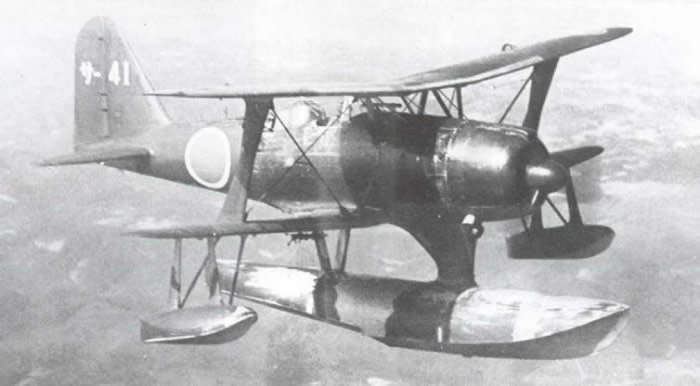 Mitsubishi F1M “Pete”, last observation floatplane used, in WW2.
Mitsubishi F1M “Pete”, last observation floatplane used, in WW2.
Interwar and wartime Modifications

IJN Abukuma in 1941 (Tamiya boxart)
In 1929 Yura received a forward catapult over guns No 1 & 2 and hangar at the bas of the bridge (like some British cruisers), and it was fitted on 1931 for IJN Kinu.
In 1932,Natori was given an aft catapult plus a quadruple 13.2mm/76 machine gun mount. It was in 1933 on Nagara and Isuzu, and in 1934 on Abukuma.
In 1934 Kinu and Yura were retrofitted also with their catapult moved aft, between No 6 & 7 guns, and same 13.2 mm mount. All from 1932 also received two 6.5mm/115 and two 7.7mm/80 AA light machine guns. From 1932 and 1937 during refits, they all also received two single extra 76mm/40 AA guns and two single 13.2mm/76 heavy machine guns.
In 1934-1935 all had their structure stiffened: Liquid ballasts added, metal bracing around the hull externally and internall, with a full displacement now to 8,000t top speed down to 32kts. In 1935-1936 their coal boilers were replaced by oil-burning ones with now a fuel stowage ported to 1,600t.
In 1937, Natori had an extra quad 13.2mm/76 mounted plus a twin 40mm/62 HI 91-shiki guns temporarily for tests (the Bofors), as Yura.
In 1938 and up to 1940 all receved two additional 13.2mm/76 AA HMGs and twi twin 25mm/60 type 96 AA guns.
Wartime saw mainly armament modifications: Abukuma received the first in 1941 two extra quadruple 610mm Torpedo Tubes in addition of her four twin banks and soon also two extra single 7.7mm/80 MGs, ported on all ships.
In 1942 only Nagara was modified, receiving an extra quad 13.2mm/76 as well as two twin mounts and in early 1943, her number 5 140mm/50 turret was removed but she gained four twin 25mm/60 AA guns 96-shiki.
In January 1943 Abukuma also the same removal of N°5 turre for the addition of a quad 13.2mm/76, a twin one, and two twin 25mm/60 96-shiki. Same was done on Isuzu in May, with two 140mm/50, No 5, 7 removed and a twin 127mm/40 89-shiki added and two triple 25mm/60 96-shiki, and she was the first with radar, equipped with a 1-shiki 2-go model. The same was added to Abukuma in October as well as on Nagara and the same month, Kinu also saw the rmoval of No 5, 7 turrets, catapult and seaplane for a twin 127mm/40 89-shiki, two triple 25mm/60 96-shiki, 2 DCR (36 depht charges) and the same 1-shiki 2-go radar. In November, Abukuma had No 7 removed and gained also a twin 127mm/40 and triple 25mm/60 plus four 25/60 96-shiki, and three 13.2mm/76 HMGs all single.
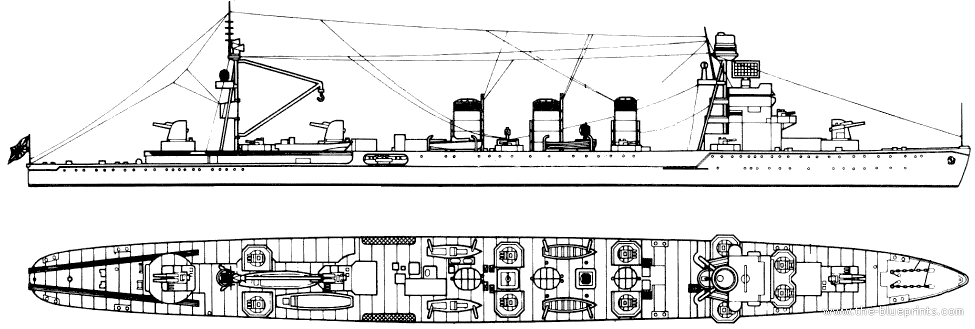
IJN Isuzu 1944
1944 some more modifications: In March, IJN Natori had her No 5, 7 main guns removed as well as her catapult and seaplane and addition of a twin 127mm/40 Type 89, two triple 25mm/60, four single 25mm/60, 2 DCR (36) for ASW escort and the same 1-shiki 2-go radar. The same month, Abukuma had her catapult and airplane removed to save weight, then a triple 25 mm added. A month later, IJN Nagara had also her No 7 removed as wel as her four twin 610mm TT, catapult and seaplane removed, but gained a 127mm/, two triple 25mm/60 four single, and two DCR (depht charge racks) (36).
In June 1944 IJN Nagara received an extra twin 13.2mm/76, eight singles, and ten 25mm/60 plus the new 2-shiki 2-go radar. Same was done on Abukuma a month later, with ten 25mm/60 96-shiki, but five single 13.2mm/76. In September, Isuzu had five 140mm/50 removed. She gained two twin 25mm/60, a quad 13.2mm/76, had her two twin 610mm TT, catapult and seaplane removed but gained two twin 127mm/40 89-shiki, nine triple 25mm/60 96-shiki, 17 single 25mm/60 and 2 DCR (36) plus the new 2-shiki 2-go radar and two 3-shiki 1-go radars and the 93-shiki 3-gata sonar, converted as an AA/ASW escort essentially at this point. This was the last large scale modification of the class.
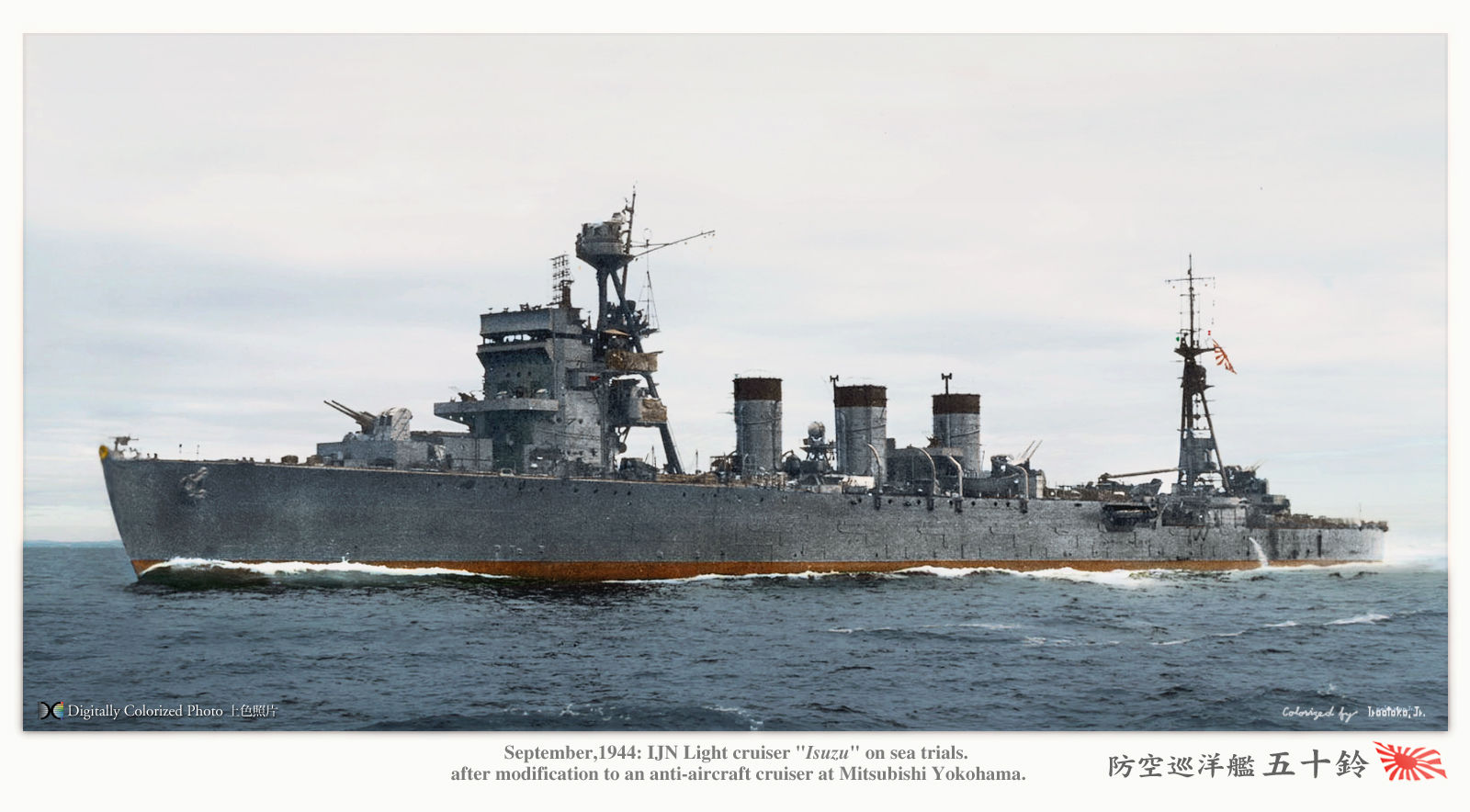
In october 1944, the surviving ships were IJN Kinu, which received in turn two 2-shiki 2-go and 3-shiki 1-go radar, and Abukuma which saw installed ten 25mm/60 AA 96-shiki guns.
Newly dedicated illustration of the Nagara class in 1941 by the author.
Other illustrations by the author depicting the Kuma and Sendai classes to compare.
Sources/Read More
Books
Gardner, Robert (1985). Conway’s All the World’s Fighting Ships, 1906–1921. Conway
Lacroix, Japanese Cruisers, p. 794
CombinedFleet.com: Abukuma & others, Tabular Record of Movement
Dull, A Battle History – Imperial Japanese Navy
Brown, David (1990). Warship Losses of World War Two. Naval Institute Press.
D’Albas, Andrieu (1965). Death of a Navy: Japanese Naval Action in World War II. Devin-Adair Pub.
Dull, Paul S. (1978). A Battle History of the Imperial Japanese Navy, 1941-1945. Naval Institute Press.
Evans, David (1979). Kaigun : Strategy, Tactics, and Technology in the Imperial Japanese Navy, 1887-1941.
Howarth, Stephen (1983). The Fighting Ships of the Rising Sun: The drama of the IJN, 1895-1945. Atheneum.
Jentsura, Hansgeorg (1976). Warships of the Imperial Japanese Navy, 1869-1945.
Lacroix, Eric & Wells II, Linton (1997). Japanese Cruisers of the Pacific War. Annapolis
Roscoe, Theodore (1949). United States Submarine Operations in World War II.
Stille, Mark (2012). Imperial Japanese Navy Light Cruisers 1941-45. Osprey.
Tamura, Toshio (2004). “Correcting the Record: New Insights Concerning Japanese Destroyers and Cruisers of World War II”. Warship International. XLI
Whitley, M.J. (1995). Cruisers of World War Two: An International Encyclopedia. Annapolis, Maryland: Naval Institute Press.
Links
The nagara class On navypedia.com
The Nagara class on Combined fleet.com
The class on homepage2.nifty.com – archive
3D rendition – by Thomas Berens
ONI booklet regoignition page of the “Natori class”.
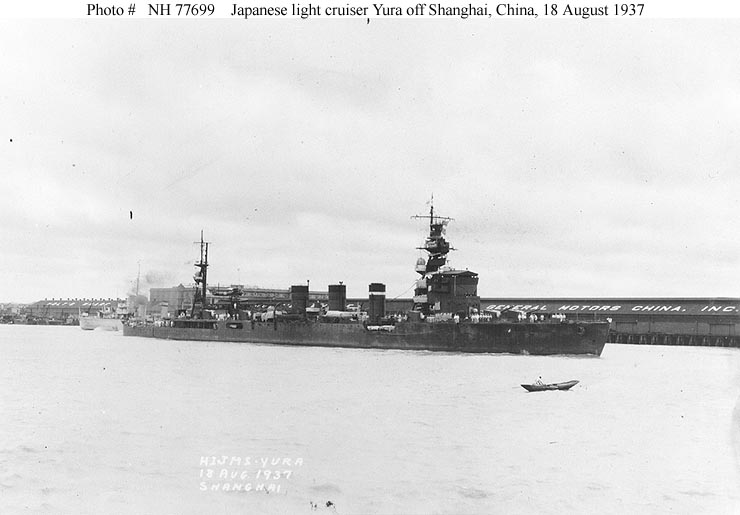
ONI USN photos of Yura, bow grand angle view at Shanghai in 1937.
The modeller’s corner

Nagara class – model kit
IJN KUMA NAGARA SENDAI Class Japanese Navy Light Cruisers Vintage Gakken 32 Book
Nagara class general query on scalemates
On the Pacific War Online Encyclopedia
Gallery

IJN Kinu’s forward catapult and aicraft arrangement in 1931, colorized by irootoko Jr.

IJN Nagara in Shanghai, 1936, colorized by irootoko Jr.

IJN Natori in Sasebo, 1935, colorized by irootoko Jr.

IJN Abukuma in 1933, colorized by irootoko Jr.
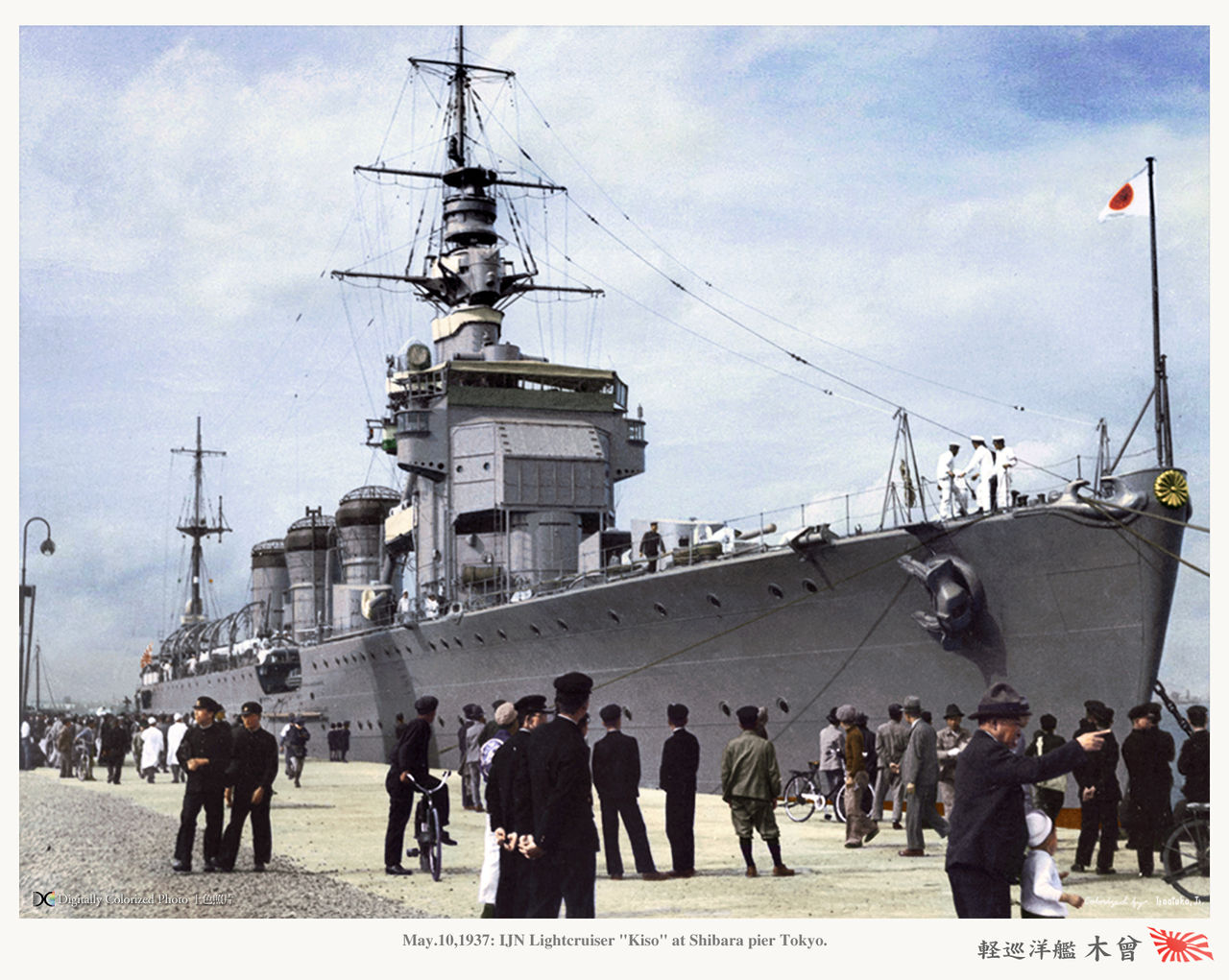
IJN Kiso in 1937
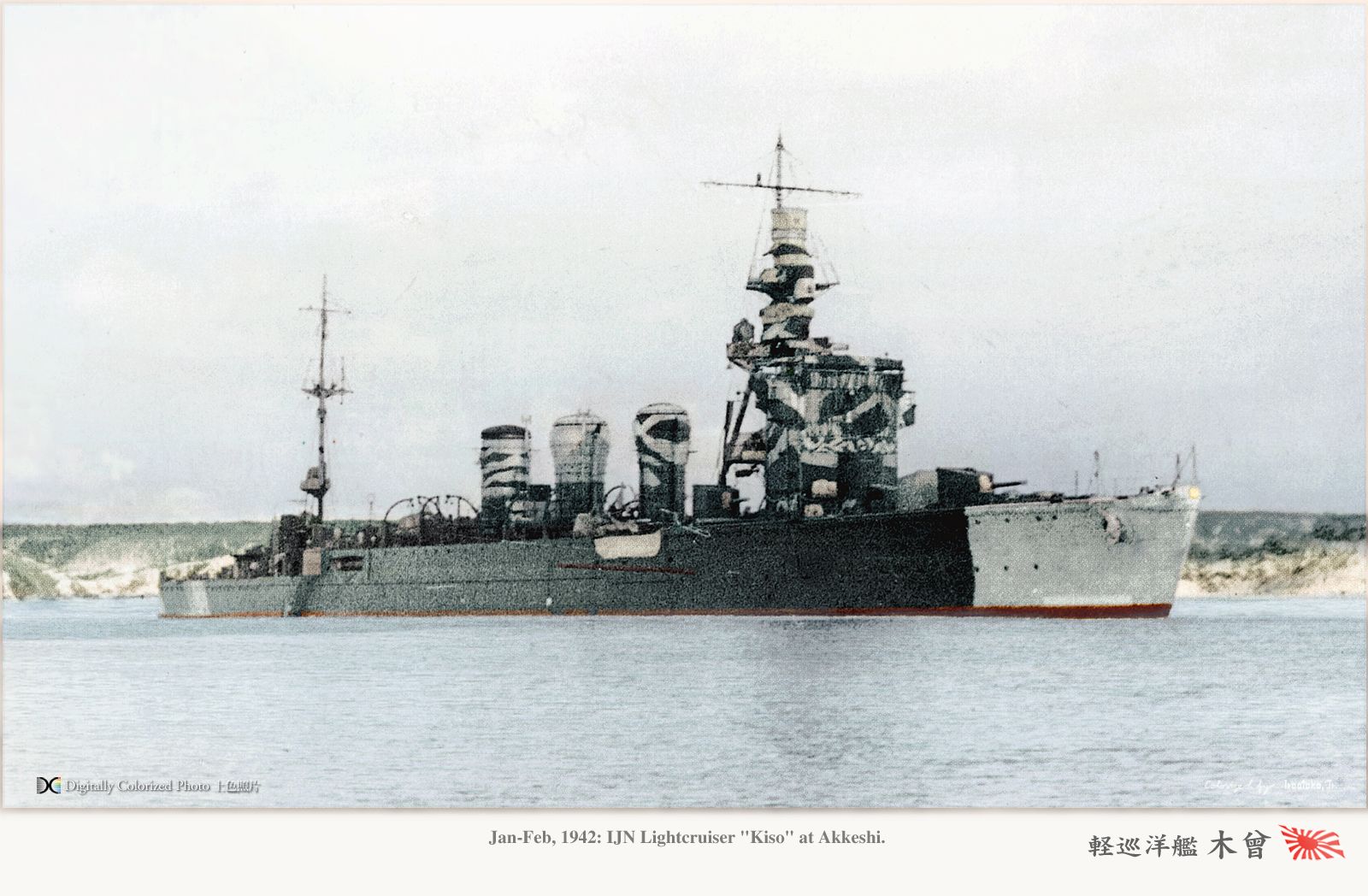
IJN Kiso camouflaged in 1942, in the Aleutians
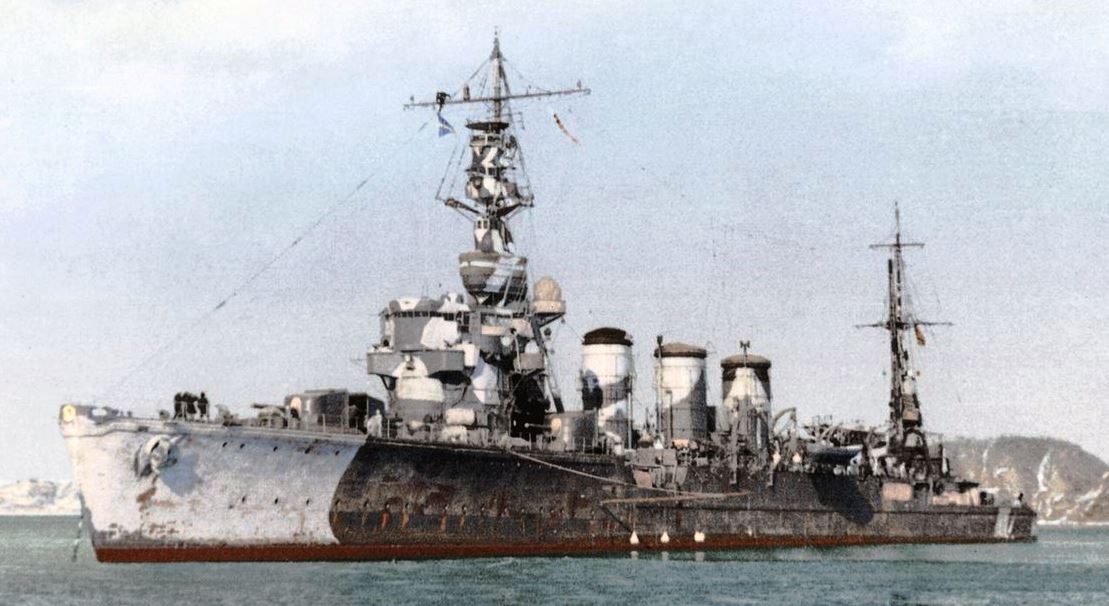
A camouflaged Tama in 1942, to compare. ONI had difficulties to tell the Kuma and Nagara classes apart. Perhaps the biggest giveaway was the Nagara’s straight funnels, like for the following Sendai. But they diverged by their bridges, masts, and bow shapes between themselves…
IJN Nagara
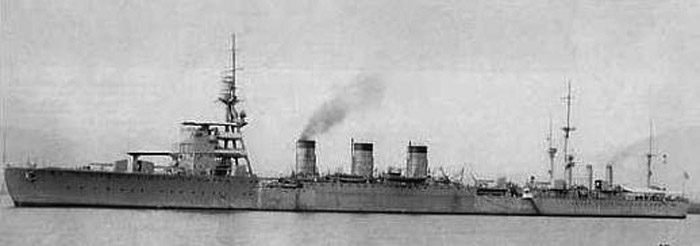
IJN Nagara in the early 1930s with her early aviation platform
Interwar career
Nagara was laid down on 9 September 1920, launched on 25 April 1921 and completed at Sasebo Naval Arsenal under command of Captain Kuroda, commissioned on 21 April 1922. Soon after she was assigned to Port Arthur, patrolling the China coast down to Tsingtao. Ship’s logs shows that ftom 10 November 1922 her new captain was Fujii Kensuke, then in November 1923 Sato Minokichi, in November 1924 Hori Teikichi, in October 1925 Yoshitake Junzo, July 1926 Yanagisawa Kyosuke, December 1927 Ban Jiro, December 1927 Sagara Tatsuo, December 1928 Sato Ichiro, the former 1st Fleet/Combined Fleet staff officer, in May 1929 Mitsui Seizaburo, November 1929 Kobayashi Sonosuke, December 1930 Waki Kanae, December 1931 Taniike Saburo, and December 1932 Watanabe Tokushiro followed by Captain Takeo Takagi in November 1934, Matsunaga Jiro, Sadamichi Kajioka (1935-1936), Matsuyama Mitsuharu. All this time, the cruiser alternated home water fleet training, overhaul/maintenance periods, and patrols along the China coast.
War in China
The Second Sino-Japanese War saw Nagara assigned to cover Japanese convoys bringing troops for the Battle of Shanghai, and continue patrolling Chinese coast, making incursions in the Yangtze River until 1939. From 14 August 1937 she was under command of Rear Admiral Tanimoto Umataro at the head of CruDiv 8, (NAGARA as flagship, JINTSU, SENDAI). They took up position for cover shelling at Woosung Flats off Shanghai. Nagara bombed Pootung, over the masts of the British sloop HMS FALMOUTH, which captain was rightously worried.
On 10 November 1937 Captain Sawada Torao took command, and on 10 May 1938 the cruiser was reaffected into Vice Admiral Shiozawa Koichi’s 5th Fleet, Nagara being appinted as DesRon 5’s flagship. With her destroyers she shelled Ho-tsu, Ni-chin, and Wu-tung, then covered an amphibious assault, 2,000 troops from Yokosuka, Kure and Sasebo, part of the Marine Special Naval Landing Forces, while aircraft from KAMOI, KAMIKAWA MARU targeted bridges, roads, ferries and ships and eventually overran the Chinese 75th Division.
On 12 May 1938 Amoy fell and in July, Capt. Ichise Shinichi took command, folloed by Edo Heitaro and in July 1939 Yano Hideo, then in September Nakazato Takaharu. With the heavy cruisers Myōkō and Nachi, Nagara participated in the Hainan Island Operation in February 1939 (Vice Admiral Nobutake Kondō). From 1st November 1940 Captain Sone Akira takes command and he was replaced on September 1941 by Naoi Toshi while the cruiser was reassigned under Vice Admiral Takahashi Ibo’s CruDiv 16, Third Fleet (Flagship ASHIGARA), also comprising the destroyer leaders KUMA and NATORI (DesRon 5).
From 30 January 1941 to 8 April 1941, Nagara took part in the Invasion of French Indochina and from 10 June 1941 to 9 September 1941, covered for the landings in southern China.
WW2: Invasion of the Philippines and Dutch East Indies
From 10 September 1941, Nagara took part in her last preparatory training and on 26 November, became flagship of Rear Admiral Kyuji Kubo, as part of the 4th “Surprise Attack Unit” in Palau when the Pearl Harbor operation started. On 11–12 December she deployed with a naval landing force, and covered the landings at Legaspi in Luzon (Philippines). She was back to Rabaul and returning there on 24–30 December, for additional landings at southeast Luzon.
In January 1942, she escorted another landing convoy, Sasebo No. 1 Special Naval Landing Force. They landed at Menado and Kendari in the Celebes. On 25 January 1942 at Kendari, the destroyer Hatsuharu collided with Nagara. Her hull was damage enough so she needed repairs at Davao while Rear Admiral Kubo transferred his flag IJN Hatsushimo. Back on 4 February 1942 Kubō transferred his flag back to her and she was deployed for the invasion of Makassar. On the night of 6-7 February 1942, submarine USS Sculpin spotted Nagara, believing she was a Tenryū-class cruiser. Two Mark 14 torpedoes were fired, one missing, the other prematurely exploding, one of the numerous mishaps of this ordnance at that time.
On 17 February 1942, escorted transports carrying the IJA’s 48th Infantry Division intended for the Dutch East Indies invasion. They landed at Bali and Java. The British submarine HMS Truant spotted Nagara and fired six torpedoes but missed, soon chased down and grenaded by destroyers (she escaped).
On 10 March 1942, the 3rd Fleet became the Second Southern Expeditionary Fleet (Vice Admiral Takahashi) but Nagara stayed Rear Admiral Kenzaburō Hara’s flagship for the 16th Cruiser Division, also comprising her sister ship Kinu and the formr school crusier IJN Natori.
On 29 March 1942, covered the landings at Christmas Island, soon to be spotted by the submarine USS Seawolf, which fired three torpedoes, all missing (perhaps some hit, but due to the Mk.14 problems, we will never know). At last 2 April 1942 IJN Nagara went back to Japan, to be overhauled at the Maizuru Naval Arsenal drydock, from 12 to 24 April 1942.
Assigned as flagship, Rear Admiral Susumu Kimura’s 10th Destroyer Flotilla (Nowaki, Arashi, Hagikaze, Maikaze, Makigumo, Kazagumo, Yūgumo, Urakaze, Isokaze, Hamakaze, Tanikaze) she was placed under command of Admiral Chuichi Nagumo, 1st Fleet and soon mobilized to take part in the battle of Midway.
Battle of Midway
IJN Nagara flanked the main Carrier Striking Force (Kido Butai, Akagi, Kaga, Sōryū, Hiryū) escorted with the battleships Haruna and Kirishima, the cruisers Tone and Chikuma. On 4 June 1942, she spotted the submarine USS Nautilus just after she launched her torpedoes on Kirishima. As Akagi was left burning, Vice-Admiral Nagumo transferred his flag to the DD Nowaki and then to Nagara. She went back to Japan
on 13 June 1942 with 500 wounded sailors to Hashirajima and the hospital ship Hikawa Maru anchored there.
Battle of the Solomon Islands
On 14 July 1942, the 10th Destroyer Flotilla returned to the 3rd Fleet which headed for her new base in Truk on 16 August 1942. They were escorting what was left of the Kido Butai, the fleet carriers Shōkaku, Zuikaku, Ryūjō, and the battleships Hiei and Kirishima, the cruisers Tone and Chikuma, and 25 August 1942, Nagara took part in the Battle of the Eastern Solomons, as escort, but left unscaved.
She was back in Truk on 5 September 1942 and sorties several times in the Solomon Islands by September. She also participated on 25–26 October 1942 to the Battle of Santa Cruz Islands, escaping damage and she was back in Truk again, until 9 November 1942: Rear Admiral Kimura and Nagara’s destroyer squadron was assigned Hiei and Kirishima’s screen for a plan to reinforce Guadalcanal with 14,500 men, equipments and suplies.
Before the landing, Henderson Field was bombarded by the battleships while Nagara patrolled around, for a possible enemy incursion. This led to the First Naval Battle of Guadalcanal (13 November) in which two of her destroyers were sunk, Akatsuki and Yūdachi while and Hiei, Amatsukaze, Murasame and Ikazuchi were damaged. Nagara was soon framed and hit by USS San Francisco, on 5-inch (130 mm) shell killed six crewmen. Nagara escaped around Savo Island with Kirishima which had Hiei in tow, later to be sunk by Henderson Field planes as well as those from USS Enterprise and B-17s from Espiritu Santo. With her poor AA, Nagara could do little to prevent her demise.
Vice Admiral Gunichi Mikawa then made a sortie for Guadalcanal again, from the Shortland Islands (Chōkai, Kinugasa, Isuzu, the DDs Arashio and Asashio). They were part of Kondō’s bombardment of Henderson Field. Nagara was in the screening unit, with Kirishima, Atago, Takao, plus six destroyers, and they will took part in the second Naval Battle of Guadalcanal on 15 November. IJN Nagara and her destroyers attacked both by gunfire and torpedes, firing all their dreaded Type 93 “Long Lance” at once. More were fired, notably at USS South Dakota, but missed, destroying however the destroyers USS Preston and Walke, and Benham, later scuttled. Kirishima and Ayanami were lost, Nagara again remained unscaved and was back to Truk on 18 November.
On 20 November 1942, Nagara was Rear Admiral Takama’s flagship for the 4th Destroyer Flotilla. IJN Agano replaced Nagara at the head of the 10th Destroyer Flotilla. The 4th DF was composed of three divisions, nine destroyers: The 2nd (3), 9th (2) and 27th (four). She trained with her new unit and then headed for a maintenance and refit at Maizuru. Her N°5 main gun was removed to make rom for extra AA. She made gunnery exercises off Saipan and received a rogue shell, exploding very close but making no serious damage not casulaty. She sailed to Truk for further operations on 25 January 1943.
By February 1943 she participated in the evacuation of Guadalcanal and in June she transported the Yokosuka No.2 Special Naval Landing Force, occupying Nauru.
South Pacific Operations
In July 1943 she escorted the aircraft carrier IJN Jun’yō, taxiing aircraft to Kavieng in New Guinea. Nagara during the night was taking her mooring when she was hit by an Austrlian mine laid by a PBY Catalina. The smaller mine than usual made light bottom damage, under her stern, but did not prevent her from furher operations.
On 20 July 1943 the 4th Destroyer Flotilla was deactivated. Nagara replaced Jintsū as flagship, Rear Admiral Shunji Isaki for the 2nd Destroyer Flotilla, 2nd Fleet: Divisions 24, 27, 31, and three extra destroyers. Nagara was relieved as flagship for Noshiro (20 August 1943), reassigned to the 8th Fleet (Vice Admiral, Tomoshige Samejima). She was also back to Maizuru for a refit (see modifications).
On 1 November 1943, she relieved Kashima as flagship, 4th Fleet (Vice Admiral Masami Kobayashi) and on the 14th, she assisted the towing of IJN Agano back to Truk (torpedoed by USS Skate).
On 22 November 1943 she left Truk after the Tarawa and Gilberts invasion. She arrived at Kwajalein on the 26th, attacked that day by several Grumman TBF Avenger and SBD Dauntless from TG 50.3’s (USS Enterprise, Essex). She took torpedo and bomb hits but was still capable of sailing back to Japan for extensive repairs in January 1944.
She was in Maizuru Naval Arsenal throughly modified, gaining notably a new unshielded 5-in HA gun mount and two new quadruple TT banks aft and triple Type 96 25-mm AA gun mounts for a total of 22 plus Depth charge racks, Type 93 hydrophone in the bow. Now fully kitted as an escort, she left on 15 May 1944, replacing Tatsuta as flagship, 11th Destroyer Flotilla, Combined Fleet. After some retraining in home waters she departed to escort a convoy to the Ogasawara Islands (June 1944) and Okinawa (July 1944). Refitted at Yokosuka on 2 July 1944, she gained an additional ten single Type 96 25-mm for a total of 32 and a Type 22 surface-search radar.
On 7 August 1944, en route from Kagoshima to Sasebo, IJN Nagara was spotted by USS Croaker, which was in the revserse direction, but 1,300 yards when she fired a four torpedo salvo from her stern, one hitting Nagara starboard aft. Due to the extensive damage and rapid flooding, her crew could nor prevent her for sinking by the stern, off the Amakusa Islands, carrying with her captain xxx and 348 crewmen while 235 crewmen were later rescued. She was only stricken officially on 10 October.
IJN Isuzu
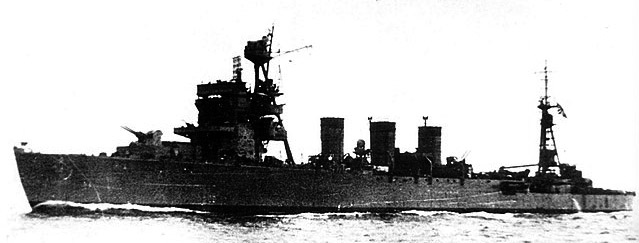
Isuzu rebuilt in 1944
On 10 August 1920 she was laid down at the Uraga Dock Company shipyard, second ship of the NAGARA class light cruisers as hull No. 171. From 1 September 1921 Captain Ishiwata Takenori is appointed the Chief Equipping Officer and she is launched on 29 October 1921, making builder’s trials and on 10 June 1923 collides with a small trawler. She is completed on 15 August 1923 and attached to Yokosuka Naval District with Captain Ishiwata Takenori in command, until 20 November 1923, replaced by Hori Teikichi and from December 1923 after basic training she is declared apt for service and assigned to CruDiv 3, 1st Fleet, with IJN TAMA and YUBARI. On 8 March 1924 she departed Sasebo for a training cruise in Chinese waters and when back, stoppoed in Mako in the Pescadores.
Early service 1924-37
She entered the drydock on April 1924 at Yokosuka for a bridge rebuild for which is added a target survey platform at the foremast searchlight platform level. On 1 December 1924: she becomed flagship of DesRon 2, Second Fleet under Captain Matsuyama Shigeru’s command. On 25 March 1925 she departed with CruDiv 5 for a training cruise to the Yangtze River. In November 1925 Captain Tamura Shigehiko took command, and on 29 March 1926 she departed Tokuyama for a training cruise to Tsingtao but on 16 October 1926 en route to Yokosuka via Osaka she ran aground in Yasuoka Bight, off Shimonoseki.
Repaired and reassigned on March 1927 to the First Dispatched Squadron with SENDAI, she is sent to patrol the Yangtze, until April 1927, to be used as TS in Yokosuka until December 1927 Captain Shizume Shizuka taked command ans is replaced on 20 August 1928 by no other than Yamamoto Isoroku, which was the former Japanese Naval Attaché to Washington. On 10 December 1928 he is replaced by Hani Rokuro and in March 1929 she Participates in Kayaba type spring-powered catapult testings. On 26 September 1929 Captain Ikenaka Kenichi takes command, replaced by Takasu Shiro and on 30 November 1929 she is reassigned to Makung Guard Unit, as a guard ship.
On December 1930 Isuzu became guard ship at Yokosuka Naval Base under command of Goto Terumichi and on 15 May 1931 she is placed in reserve at Yokosuka for refit: Her tripod foremast is reinforced as she gained an extending fire command station with a new lookout post built forward. On 14 September 1931 Horie Rokuro takes command, replaced by Aihara Aritaka on 14 November 1931, on 16 February 1932 Masaki Katsuji, 20 June 1932 Yamada Seizo until her new refit from 24 September-1 December 1932 at Yokosuka Navy Yard. The bridge structure is extended, AA increased and the old 6.5-mm MGs replaced by Lewis type 7.7-mm.
From 15 November 1932 Yamaguchi Minoru takes command and from 1st December she is reassigned to the Mako Guard Unit as a guard ship but participated later in the search of survivors from the lost destroyer IJN SAWARABI, finding and rescuing 14 officers and men. She then departs for the south China coast, based at Formosa, patrolling in December 1932-August 1933 and from 29 August 1933 to 17 February 1934 she is refitted again at Yokosuka Navy Yard. with her pole mainmast replaced by a tripod, supporting a Sperry type 90-cm searchlight. She also received a Kure Type No. 2 Mod. 3 catapult to launch her Nakajima E4N2 Type 90 floatplane. On 1st November she is assigned to CruDiv 7, First Fleet as flagship and on 15 November 1933 Yamada Mitsuru taked command.
From 30 October 1934 to 15 January 1935 she is refitted at Kure Navy Yard, with topside fittings reduced, ballast added for stability, radio equipment modernized, mixed-firing boilers converted to oil-firing only, and on 15 November 1934 Makita Kakusaburo takes command, as she is placed in reserve at Yokosuka Guard Squadron. Chiba Keizo succeeded him, then Hara Kenzaburo, and Matsunaga Sadaichi.
Isuzu in the Sino-Japanese war 1937-39
From 1st December 1936, she takes the head of SubRon 1, First Fleet under command of Yamaguchi Tamon. On 20-23 August 1937 she was flagship of ComSubRon 1 (Rear Admiral Komatsu Teruhisa), and joined BatDiv 1 (NAGATO, MUTSU), BatDiv 3 (HARUNA and KIRISHIMA) escorting troopships of the IJA (11th Division) from Tadotsu to Shanghai and the battle developing there, as the 2nd Sino-Japanese war breaks out.
On 25 August 1937 she was back Sasebo, but departed for another escort run on 17 September, and patrolling southern Chinese waters until stopping at Mako on October 1937.
From 1st December 1937 Captain Nakamura Motoji taked command and on 1st 1 March 1938 she is refitted at Yokosuka, having AA modifications and four 90-cm Sperry type searclights replaced by three 110-cm Type 92s. It is over on January 1939 and after training in home waters on 20 November 1938 Captain Hashimoto Aiji takes command. From 15 November 1939 she became flagship of SubRon 2, Second Fleet and latter Tsuruoka Nobumichi is appointed while in March the next year, she departs Nakagusuku Bay in Okinawa, to patrol in southern Chinese waters, arriving in Takao, Formosa, her operating base on 2 April 1940. On 25 August 1940 she departed for her first patrol, unti back in September to Yokosuka, while in November her unit is reassigned to the Sixth Fleet.
On 1st September 1941 Captain Ura Koichi takes command and she is reassigned to 15th Escort Squadron (Vice Admiral Hara Kiyoshi), to escort the Second China Expeditionary Fleet, with the gunboats HASHIDATE and SAGA, the TBs HIYODORI and KASASAGI. From 16 September 1941 she takes part of a naval blockade of southern Chinese coast and on December 1941 departed Amoy to participate in the anticipated invasion of Hong Kong, Operation “C” taking plane on 7 December.
Isuzu in WW2
Isuzu remained in Hong Kong until April 1942 after the city fells, and was briefly back in Mako to escort troopships for the Japanese 25th Army to Singora in Thailand, and Camranh Bay in French Indochina.
After her unit is dissolved, in April, Isuzu is reassigned under Rear Admiral Kenzaburo Hara’s CruDiv 16, assigned to Vice Admiral Ibō Takahashi’s 2nd Southern Expeditionary Fleet, joined by IJN Natori and Kinu. She then patrolled the Dutch East Indies from Makassar in the Celebes to Balikpapan in Borneo and Surabaya as flagship of CruDiv 16 in May. On 28 June she is back to Yokosuka for and overhaul, after which she departs to take part in the Banda Sea Operation (26 July 1942) covering landings of the Tanimbar Islands.
In August, 1942, Isuzu is sent to the Indian Ocean, patrolling between Singapore, Mergui, Burma, Sabang Harbor, Sumatra and Penang in Malaya and on 24 August, sent back to Makassar to participated in the Solomons campaign.
On 16 September 1942, she sailed with Kinu, escorting transports under overall commnd of Lieutenant General Masao Maruyama’s (2nd Infantry Division) from Batavia, redeployed to the Solomon Islands. Off Shortland, Isuzu is ordered to Truk, replacing IJN Jintsu as flagship (Rear Admiral Raizo Tanaka), taking charge of DesRon 2 (DesDivs 15, 24, 31, nine destroyers). On 11–12 October 1942 she escort DesDiv 31 to Guadalcanal, with battleships, aircraft carriers Jun’yō, CruDiv 4 and CruDiv 5, providing cover with DesDiv 15 and 31; She fired on USMC fortifications on Tulagi, close to Henderson Field.
On 24–25 October 1942, she taks part in the Battle of Santa Cruz, renaming undamaged. On 3–5 November 1942, she escort troopships for the 38th Infantry Division in Shortland, and soon participated in the second Naval Battle of Guadalcanal, just having near-misses from SBD Dauntless but this cuased floosing, loosing her No. 3 boiler room. Assisted later by Asashio she is back to Shortland for emergency repairs from IJN Yamabiko Maru, enough for complementary ones in Truk (20 November 1942) and Yokosuka (14 December) for the remainder.
There, she also received her Type 21 air-search radar and AA and TTs modifications. On 1 April 1943 she was assigned to CruDiv 14 (Rear Admiral Kenzo Ito), sailing with IJN Naka. Departing on 21 May 1943, with supplies and troops for Truk she arrives on 21 June 1943, assigned to ferry more troops to garrison Nauru Island (25 June). From Truk she is recalled to Tokushima, ferrying troops to Shanghai. On 23 October 1943 she is ambushed in the East China Sea by USS Shad. The latter fired all ten torpedoe, which all “missed”.
Isuzu is back to 28 October 1943, assigned to an escort for Kavieng in New Ireland, attacked 60 miles (97 km) north by USAAF’s (13th Air Force) B-24 Liberators. But she emerged unscaved of the carpet bombing, and is however damaged later by a mine laid by the submarine USS Silversides. Hull damage disabled two gun mounts, forcing her back to Rabaul for repairs. She was there on 5 November 1943 during the famous raid of Task Force 38. They only strafed Isuzu, which escaped major damage.
Attention focus back to the south pacific, Operations in South Pacific and on 20 November she is informed of the USN launching “Operation Galvanic” (Gilbert Islands), so she is ordered to ferry troops from Ponape to Kwajalein and Mili. While underway off Roi on 5 December she is taken as target by a squadron of Douglas SBD Dauntless and Grumman TBF Avenger (TG 50.1, USS Yorktown, Lexington). Sheis damaged but suvived, having mostly near-misses and is repaired at Kwajalein, Truk, and then Yokosuka (from 17 January 1944).
There, the admiralty decide to convert her fully into an escort anti-aircraft cruiser, at Mitsubishi. On 20 August 1944 when completed, she became flagship of Rear Admiral Heitaro Edo, CruDiv 31, an antisubmarine unit. The cruiser train heavily with new recruits until declared combat ready on 14 September 1944. She then departs for the Philippines, soon taking part in the Battle of Leyte Gulf as part of the Northern Mobile (“Decoy”) Force. Her former E7K2 floatplane was sent to Palau.
Battle off Cape Engaño on 25-26 October saw her attacked by Halsey’s TBM-1C from VT-21, TG 38.4’s (USS Belleau Wood) VT-51 (USS San Jacinto) which badly damaged IJN Chitose. Isuzu tried to take her in tow but she sank and the cruiser next rescued 480 survivors. She also tried to cover IJN Chiyoda, damaged by the Lexington and Franklin until four US cruisers, nine destroyers are spotted in hort pursuit. Chiyoda is sunk with all hands, Isuzu picking up a few survivors before fleeing the scene, under fire. She received a few hit, killing 13.
Back to Okinawa on 27 October 1944, then Kure, Isuzu is assigned to a dangerous transport run to Manila and Brunei. On 19 November 1944 she was potted 55 miles (89 km) west of Corregidor when ambushed by USS Hake. Of six torpedoes launched, she is hit by one. Her stern was blasted away and she lost her rudder. Nevertheless, her crew did wonders repairing her at sea enough for her to limp into Singapore for temporary repairs, before transferred to Surabaya dock, on 10 December 1944. She left the docks on 4 April 1945, to transport and escort an army detachment from Kupang to Sumbawa.
She was spotted by the subs USS Chad, Besugo and Gabila, later joined by HMS Spark and attacked on 6 April 1945 north of Sumbawa, by ten alerted B-25 Mitchell (No. 18 Squadron RAAF, Batchelor Airfield, Darwin). She is near-missed and slightly damaged (starboard bow), and succeed in her mission on 6 April, landed troops at Bima Bay. Withdrawing near Flores she is then targeted by B-24 Liberator bombers (No. 21, No. 24 Squadrons RAAF from Australia). Two are shot down by fighters, and she escape the carpet bombing unscaved by her bow damaged by near misses.
She is then ambushed on the 6th between Sumbawa and Komodo Islands by USS Besugo. Nine torpedoes are launched by missed, although one struck a Japanese minesweeper. On 7 April 1945, she is ambushed 60 miles NW of Bima by USS Gabilan. She launched five, and hit once. The torpedo struck portside at the bridge’s section. Massive flooding forward followed, and she is unable to steam beyond 10 knots (19 km/h), listing and eventually settling by the bow, dead in the water. Her crew frantically tried emergency repairs when USS Charr (LtCdr Herman E. Miller), informed, arrived at the scene and fired four torpedoes. Isuzu is struck portside by two more torpedoes, flooding instanty her aft engine room. Two more torpedoes are fired frol closer, broking her bow completely. Order was given to abandon ship and she sank, witnessed by USS Spark, Captain Matsuda and 450 crewmen being rescued by the submarine, while 190 went down. The same day Yamato was sunk while attempting to reach Okinawa. Isuzu was officially stricken on 20 June 1945.
IJN Natori
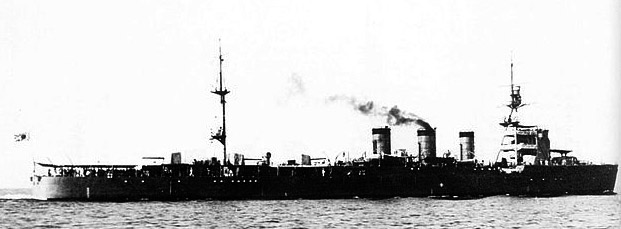
IJN Natori in 1922 off Nagasaki
IJN Natori’s early carrier
Natori (名取), was completed at (Mitsubishi) Nagasaki shipyard, on 15 September 1922 and after commissioning starting her patrols off the China coast. From there, under command of Captain Soejima Keiichi she started her training cruise in home waters. In November 1922 Morita Minoru became her new captain, followed by Ogura Taizo (1923), Inoue Shiro (1924) Kashima Tsugitaro (1925), Mizushiro Keiji (1926), Matsumoto Chuza and in 1927 Captain Tsuda Takehiko, Arichi Jugoro, Higurashi Toshiu (1928) Sada Kenichi, Oyama Yoshiro (1929) Miki Taichi (1930), Hoshino Kurakichi (1931), Sakabe Seizo, Goto Terumichi (1932), Matsuki Masukich, Matsuura Eijiro (1933), Kishi Fukuji (1934), Okamura Masao (1935), and Nakahara Yoshimasa (1939).
From 1938, Natori was based in Formosa, helping to cover landings in southern China. Present oon board from 10 November 1937 Captain Nakao Hachiro is replaced on 5 December 1938 by Aruga Takeo and on 15 November 1939 by Matsubara Kanzo. On 15 November 1940 Yamazumi Teijiro takes command, while the border dispute between Siam and French Indochina became a full scale war. Despite a clear-cit Frencj naval victory at Kho-Chang, on land, Siamsed troops gained a considerable foothold, until a Japanese-sponsored “Conference for the Cessation of Hostilities” held at Saigon enabled a cease-fire, signed aboard IJN Natori on January 31, 1941.
On 26 November 1941, IJN Natori was appinted as flagship, Rear Admiral Kenzaburo Hara DesRon 5, under overall command of the 3rd fleet (Vice Admiral Ibo Takahashi). She is reassigned to the No.1 “Surprise Attack Unit” to the conquest of the Philippines.
Natori at the battle of Sunda Strait
On December, 7, Natori escorted six transports (48th Infantry Division) from Mako to Aparri in northern Luzon. She covered the landing force, bombed by three USAAF B-17 bombers (14th Squadron) on 10 December 1941. Natori and Harukaze are damaged by the blast and shrapnel of near misses. She was repaired at Mako, and she was back, ferrying 27 transports (47th Infantry Regiment, from the 48th Infantry Division) and the 4th Tank Regiment. They were landed at the Lingayen Gulf later this month.
On 26 December 1941 IJN Natori is reassigned to second Escort Unit together with IJN Kashii. She carried out the escot of 43 transports, for Malaya invasion, bound to Singora. During the Dutch east indies, while covering the invasion force she participated in the Battle of Sunda Strait, on 28 February 1942. She sailed with destroyers from DesDiv 5, 11, 12, 27 and CruDiv 7 (Mikuma and Mogami) deployed off the landing areas. USS Houston, HMAS Perth bound for Tjilatjap went through the Sunda Strait, spotted and attacked troop transports defended by IJN Harukaze, Hatakaze and Fubuki. They thrown smoke to mask them and IJN Fubuki made a torpedo charge towards both cruisers, missing them.
IJN Natori and destroyers arrived at the scene, screening Mogami, Mikuma and Shikinami. Natori charged ahead with Hatsuyuki and Shirayuki, opening fire at a close, torpedo range. At 23:08, the Allied cruisers turned northeast, shadowed by Natori, to the southeast in three columns. At around 23:19 they launched 28 torpedoes, but missed, whereas Perth managed to hit Harukaze and Shirayuki. Soon, Mikuma and Mogami fired their “Long Lance” torpedoes from 9,300 yards (8,500 m) while opening fire, from 12,000 yards, using the closer Destroyer’s searchlights on Perth. At 23:27, Mogami fired six torpedoes at Houston, missing them, but hitting Army transports with the 16th Army onboard.
Harukaze and Hatakaze launched torpedoes, then Shirakumo and Murakumo, for a grand total combined of 90 torpedoes and Perth took the first torpedo hit, then two more and sank 3 nautical miles NE of St. Nicholas Point, after a fourth torpedo hit, followed by USS Houston.
Pacific Operations 1942-43
On 10 March 1942, IJN Natori joined CruDiv 16, with her sister ship Nagara. She took part in the Battle of Christmas Island, and on 1 April 1942, but she was torpedoed on her way back by USS Seawolf (firing three torpedoes, missing). IJN Naka was however hit near her No.1 boile, later towed back to Bantam Bay by IJN Natori. In April, she started to patrol of the Java Sea, also in May and June. She was later refitted in Maizuru, and operated aftwards in Java Sea, Timor Sea until late December 1942. She was frequently based or resupplied at Mergui and Penang (Burma) but also Singapore and Davao.
On 21 December 1942, Natori led a Special Naval Landing Force bound to Hollandia in New Guinea. She covered the landing and retreated back with the troopships. On 9 January 1943, while en route for another mission, she was spotted and then ambushed, 18 nautical miles southeast of Ambon by USS Tautog. At 3,000 yards the USN fleet sub fired two torpedoes, and hit Natori in her stern, which broke off with the rudder. Natori however managed to manoeuver with her shafts, underway at reduced speed, and USS Tautog fired two more torpedoes, but they either missed or were duds and Natori managed to escape.
On 21 January 1943 Natori was stationed in Ambon, for rest and resplenishing when she was attacked by B-24 bombers from the 90th Bomb Group’s, 319th Bomb Squadron. She was damaged by a near-miss starboard side: The 500 lb (230 kg) bomb buckled plates open, caused flooding to the No.2 boiler room. Emergency repairs were done and she departed for Makassar, and then Seletar Naval Base in Singapore where there was a drydock for her. Repairs under partially on 24 May 1943, but she was sent to Japan to complete it while modernizing her. At Maizuru two turrets, catapult and aicraft were removed for extra AA and modern radars and hydrophones in her bow. It was complete on 1 April 1944 and Natori became flagship for the Central Pacific Fleet’s DesRon 3.
Philippines Campaign 1944
On 5 June 1944, after some intensive training, she carried an IJA detachment from Kure to Davao in the island of Mindanao, Philippines, disembarked them and embarked other troops for Palau (she arrived on 17 June, just before the Battle of the Philippine Sea). IJN Natori was stationed in Davao as guard ship, taking no part in it. On 20 July 1944 while underway she was spotted off Davao by USS Bluegill. She gaine a good firing position but missed. Natori was in Palau on 21 July 1944, evacuating 800 Japanese and Korean “comfort women” to Davao.
On 18 August 1944 she escorted the transport T.3 to Palau when at 200 nautical miles east of Samar, the convoy was spotted by USS Hardhead, east of San Bernardino Strait. Believing Natori was a battleship she closed in for a surface attack, fired a first salvo of five Mark 23 torpedoes from 2,800 yards. On hit the cruiser’s port boiler room. Flooding was instantaneous and she stopped dead in the water. Soon after she received another hit starboard amidships, a second salvo of four Mark 18 torpedoes. This was enough to completely flood her to the waterline and naturally she lost balanced, listed and capsized, sinking at 07:04 with 330 crewmen (and Captain Kubota).
IJN Uranami and Kiyoshimo, part of the escort, managed to rescued 194 survivors. USS Stingray later escued 4 more survivors in a rubber raft. On 12 September 1944 the last alived survivors in a lifeboat were picked up by the destroyer USS Marshall. It is possible that three more cutters (180 survivors) managed to reached after 13 days of rowing a Japanese torpedo-boat station NE of Mindanao, close to Surigao. She was stricken on 10 October.
IJN Yura
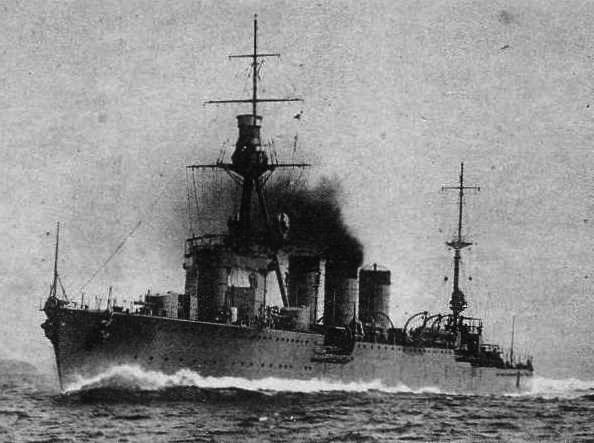
IJN Yura 1920s
Yura was laid down on 21 May 1921, launched 15 February 1922, completed in Sasebo, on 20 March 1923, then trained intensively in 1924-26 (unknown captain). From November 1926 Toyoda Soemu assumes command, then Otagaki Tomisaburo in 1928, Wada Senzo (1929), Tanimoto Umataro (1931). On 4 February 1932 she sailed with IJN NAKA and ABUKUMA for her first war mission: Shelling the batteries of Wusong Fort near Shanghai. The was still was not official. On 13 February with YUBARI she covered the 9th Division attacks of Wusong Fort, until it is taken. The shelling caused minor structural damage highlighting the need to reinforce their light hulls. She tested new systems: In 1930, aircraft catapults (in front of her bridge), in 1933-34 a rotating catapult amidships and new mainmast type for an aircraft derrick. Yura has been deployed to Shanghai already in early 1932 (Captain Mataro Tanimoto was in command since December 1932, then Rokuzō Sugiyama until November 1933, patrolling the Chinese coast and escorting troopships under Wakabayashi Seisaku.
On 7 July 1937 Yura is mobilized during the Marco Polo Bridge Incident over the Hun River, Lukuokiao in China. This is the start of an undeclared war on China begins. She covered landings of Japanese troops in northern China. From 11 August 1937, she is placed under Rear Admiral Chuichi Nagumo in the 8th Cruiser Division (with NATORI, KINU) and Vice Admiral Kiyoshi Hasegawa, Third Fleet for the first landings at Shanghai. The Third Fleet is assigned full oversee of all operations in China for the IJN. From 15 November 1938 Ichioka Hisashi took command and on 1 September 1941, Captain Miyoshi Teruhiko, as she becomes flagship for Rear Admiral Tadashige Daigo, SubRon 5.
She is prepared soon for war this time against the US. On 26 November 1941 she departs Sasebo for Palau with SubRon 5 and SubDiv 29 (I-62 and I-64). SubRon 5 is diverted to the Malay Force (South Area Force) covering the attack on Samah harbor in the Hainan Island, then in Occupied China. On 2 December 1941 Operation “Z” (Sakusen Z) is started and “Niitakayama nobore 1208” is received from the Combined Fleet, now setting the date of 8 December for the attack. On 3 December Yura was in Samah with SubRon 5, departing two days later to cover the first wave of the Malaya Invasion Force (with ComSubRon 5).
Early Pacific Operations
After covering the the Malayan Invasion at the Cape of Camau in French Indochina, on 9 December 1941, Yura was dispatched in a wild hunt for Royal Navy’s Tom Philipps “Force Z”, HMS Prince of Wales and Repulse escorted by destroyers. Yura was warned by the spotter sub I-65 that the British were close, but due to garbled communications, location was unclear. In between, Force Z was targeted by waves of torpedo bombers (IJN’s 22nd Air Flotilla from Indochina) and sunk. Yura and her submarines were too far away to act.
Later she is assigned to the invasion of Sarawak, planned for 13–26 December 1941, and covered the landings at Brunei, Miri, Seria, and Kuching. The Kawaguchi Detachment and N°2 Yokosuka Special Naval Landing Force captured Miri airfield and associated oil fields, crucial for next operations. Yura departed back to Camranh Bay and spent the rest of the year there. She was mobilized in February, to join again Vice Admiral Ibō Takahashi’s Third Fleet and aprticipated in the invasion of Sumatra, covering landings at Palembang, Banka Island, Bantam Bay and Merak, on Java Island.
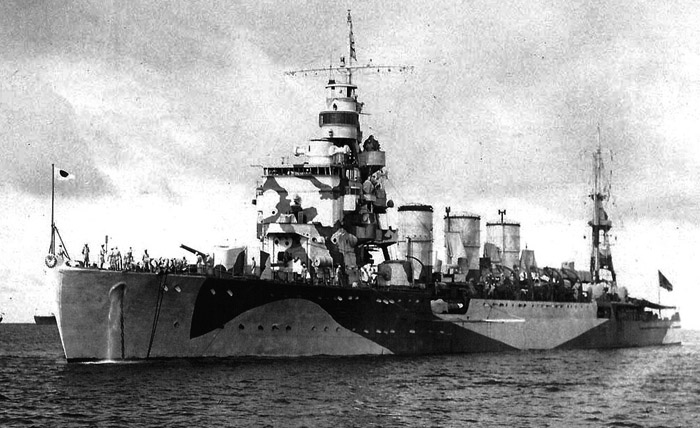
IJN Yura camouflaged, 1938
On 1 March 1942, she is spotted and attacked by the Dutch submarine HNLMS K XIV; Two torpedoes are fired from 2500–3000 meters but missed (or duds). Destroyers soon depth charges her but she escaped via Sunda Strait and reached Colombo in Ceylon. On 4 March 1942, Yura rescued the crew of tanker Erimo previously sunk by USS S-39. On 6 March she is assigned to No. 1 Escort Unit, covering more troop landings in Sumatra, then Andaman Islands.
In April 1942, IJN Yura joined the large raiding fleet assembled for the Indian Ocean Operation (Vice Admiral Jisaburō Ozawa, Second Expeditionary Fleet). IJN Yura sails with Ayanami, Yūgiri, Asagiri, and Shiokaze from Mergui, crossed the Bay of Bengal, soon joining IJN Chōkai, Suzuya, Kumano, Mikuma and Mogam, and the light carrier IJN Ryūjō. Thsy started to prey on merchant shipping in the region and on 6, some 14 miles (23 km) east of Kalingapatnam (Bay of Bengal), Yura and Yūgiri spotted, catch and shelled until sunk, the Dutch merchantman Batavia bound to Karachi. Next, they sank the Dutch Banjoewangi, the British steamer Taksang. Shot of ammunition and fuel, Yura retires to Sasebo for a refit.
On 10 May 1942 IJN Yura was flagship, Rear Admiral Shōji Nishimura DesRon 4. At Midway she joined the DesDiv 3 (Captain Ranji Oe) and DesDiv 9 (Captain Yasuo Satō). They were all under overall command of Vice Admiral Nobutake Kondō but only screen the fleet which was never engaged in the battle. Meanwhile, the Kidu Butai is devastated and Yamamoto decided not to pursue the Americans.
On 7 August 1942, “Operation Watchtower” commence as the 1st Marine Division lands on Guadalcanal, Solomon Islands. IJN Yura was in Truk (Kondō’s 2nd Fleet) as cover for the reinforcements. She took therefore part in the Battle of the Eastern Solomons seeing Ryūjō sunk and Chitose damaged, but she was unscathed, back to Truk on 5 September. She then patrolled between Truk and the Shortland Islands and on 25 September off the latter, she was carpet-bombed by two Boeing B-17 bombers (USAAF 11th Bomb Group, Espiritu Santo) and took light splinter damage by near-misses.
On 11 October 1942 during another sortie she was ambushed by the submarine USS Sculpin. The latter fired and claimed a torpedo hit forward, but post-war records are not confirming it. The cruiser was not repaired afterwards anyway, so it was likely a dud. On 12 October she departed Shortland with the seaplane tenders Nisshin and Chitose after their raid on Guadalcanal. On the 14th she covered the landing of 1,100 troops on Cape Esperance in Guadalcanal. She was also part of the “Tokyo Express” run of 17 October (2,100 troops and field artillery, anti-tank guns).
On the 18th Yura is ambushed by USS Grampus (off Choiseul Island) as the latter fired four Mark 14 Torpedoes, making just a dud (and dent) on her port side. On the 24th she left her base in Shortland for Guadalcanal (No.2 Attack Unit, Rear Admiral Tamotsu Takama -flagship Akizuki-) with the destroyers Harusame, Murasame and Yūdachi. They arrived at the north entrance, Indispensable Strait a day after, just before the Battle of the Santa Cruz Islands that she missed.
Later she led her attack group off Santa Isabel Island when attacked by five SBD Dauntless (VS-71), struck aft by two bombs, close to the engine room. Flooding was extensive and she eventually settled by the stern but her crew managed to contain the flooding and she was still able to steam away with her remaining boiler rooms.
Vice Admiral Mikawa (Eighth Fleet), when informed cancelled Takama’s operation. While No. 2 Attack Unit went back to Shortland, with Yura limping behind, she was attacked by three USAAF P-39 Airacobras and four SBD, but they missed to cause a more fatal damage. Captain Shiro Sato upon ariral tried to beach IJN Yura when she was attacked by four SBDs escorted by three F4F Wildcats, four P-39s. straddled, but not fatally, and later by six USAAF B-17s from Espiritu Santo. They put Yura ablaze, crippled, and at 18:30 the captain ordered to abandon ship, and ordered the destroyers Harusame and Yūdachi to have her scuttled by torpedoes. After she broke in two, her stern was still floating around 19:00, when sunk by gunfire off Savo Island (by Yudachi) and Yura was striken on 20 November 1942.
IJN Kinu
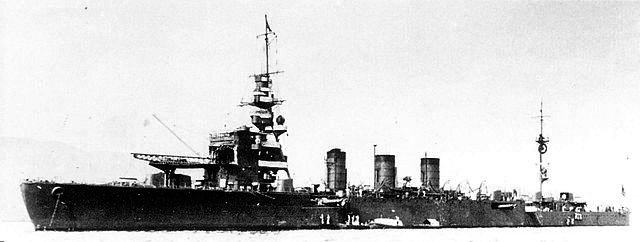
Japanese cruiser Kinu in 1931
IJN Kinu (鬼怒) Kinu was built, and completed on 10 November 1922 at Kawasaki, Kobe. She was under command of Captain Koshirō Oikawa in 1923-1924. Soon after her sea trials, she returned to the drydock to replace of all her four defective Gihon steam turbins. Repairs needed to have her gutted so it took until May 1924. Nothing much happened bedore 1934, with her home training routine, visits to nearby port, including in China and Port Arthur, Tsingtao, and until 1935 she served as training vessel under command of Captain Shigeyoshi Miwa. She made a tour of duty during the Second Sino-Japanese War, supporting landings in central and southern China, patrolled Chinese waters until 1938.
In 1938-40, nothing much happened, but on 20 November 1941, she became flagship, Rear Admiral Setsuzo Yoshitomi for SubRon 4. The latter was based at Iwakuni in Yamaguchi province and also comprised SubDiv 18 (I-53, I-54, I-55), and SubDiv 19 (I-56, I-57, I-58). She moved later to Hainan to cover further landings planned in searly December, for the invasion of British Malaya
WW2 the hunt for Force Z
On 9 December 1941, I-65 spotted and reported Force Z underway, received by Kinu and Yura via the long-range 81st Naval Communications Unit in Saigon. Reception was poor however and location could not be pintpoins so confirmation was asked for. After 90 minutes of decoding and relaying Vice Admiral Jisaburo Ozawa’s message from Chōkai, Kinu and Yura started to head in the “suppose general direction” of the last spot, but they wanted confirmation, and a second report from I-65 was blurred by the closing by of IJN Kinu’s own Kawanishi E7K “Alf”, its pilot mistaking her for an allied submarine and making a close flyby. Force Z nevertheless was located again the following day and finished off by a massive IJN aviation attack.
Invasion of Malaya and Dutch East Indies
On 13 December 1941 Kinu departed Cam Ranh Bay, teaming with IJN Chōkai, Mogami and Mikuma, the Hatsuyuki and Shirayuki to offer protection for the invasion force bound to land at Kuantan in Malaya. Next on 17–24 December, she covered landings in Brunei, but also in nearby Sarawak, securing the assault of the “Kawaguchi Detachment” and the No.2 SNLF on Miri. Once completed, she returned to Cam Ranh Bay but was mobilized again in March 1942.
She covered next other landings in Malaya, Sarawak and Java but her convoy was caught in the Java Sea, west of Surabaya. The British launched at them their old Vickers Vildebeest biplanes, protected by 15 ANZAC fighters. IJN Kinu was straddled by near-misses. They made little damage by snrapnel but killed three crewmen. On the 2th, the cruiser was attacked again, north of Surabaya, this tme ambushed by the wintage WWI USS S-38, launching four torpedoes which missed. From the 10th she joined to Sentai-16 in Makassar, then in Ambon.
New Guinea campaign
From 29 March she assigned to “N” Expeditionary Force (Fujita) setup for the invasion of Dutch New Guinea. She joined a combined force with IJN Chitose, Yukikaze, Tokitsukaze, Tomozuru, Hatsukari and several troopships. This operaton ended in late April and she was back in Ambon. By late May, Kinu returned home, drydocked for short maintenance and modernization at Kure Naval Arsenal. When back she was sent to patrol waters of the Java Sea in June-September.
On 13 September 1942, she carried reinforcement for the Solomons (2nd Infantry Division from Batavia) with Isuzu, landed at Shortland Island, and Bougainville in late September 1942. She then patrolled the Timor Sea, eastern Dutch East Indies until the end of the year and January 1943. On the 21th, she proceeded to Makassar to assist Natori, adly damaged by near-misses from B-24 bombers, at Amboina harbor, Ambon. She escorted her back to Singapore’s drydock and returned to her patrol routine off Makassar in June 1943, resupplying and carrying troops to New Guinea.
On 23 June 1943 she crossed the Makassar Roads with Kuma, dropping anchor at Juliana Quay, near Ōi and Kitakami when they were bombed by 17 B-24 (319th Squadron/90th Bomb Group, 5th Air Force). No hit was recorded, but all were straddled and badly shaken by near-misses. There was light damage and injuries only. Afterwards, Kinu returned to Japan for a major overhaul, arriving on 2 August in Kure. She was out on 14 October 1943, departing to Singapore with troops and supplies. She patrolled between there, Malacca, Penang, Batavia until January 1944.
On 23 January 1944, she departed with Aoba, Ōi, Kitakami, Shikinami to escort troop transports from Singapore to Port Blair in the Andaman Islands. Underway back to Singapore IJN Kinu towed the torpedoed IJN Kitakami to safety. She then patrolled the western Dutch East Indies and in April made another escort from Saipan, via Palau, to the Celebes, and the Dutch East Indies at large. On 27 May 1944 “Operation Horlicks” (Biak) had Kinu, Aoba, and three destroyers scambled to meet the US fleet, departing Tarakan and heading for Biak with 2,300 troops onboard. Sighted by B-24s, they were however ordered back due to the invasion of Saipan taking place instead and their troops were disembarked at Sorong.
On 6 June 1944, she was off Weigo Island in New Guinea with Aoba when near-missed by a raid of B-24 bombers (5th AF, 380th Group). After remaining on station, she resumed patrolling the western Dutch East Indies until August 1944, missing the June battle in the philippines.
Philippines Campaign
On 25 September 1944 as “Operation Sho-I-Go” took place, Kinu, still teaming with Aoba and IJN Uranami were placed under orderes of Kurita’s First Raiding Force. On 11 October 1944 however, Aoba collided with Kinu whe training off Lingga. Damage was light and did not impaired them. On 21 October as part of Sentai-16 she was sent to assist Kurita’s Force escorting a Southwest-bound transport fleet with 2,500 IJA soldiers (41st Regiment) to Ormoc on Leyte.
Sspotted en route by USS Bream on the 23th, the latter fired six torpedoes and Aoba was hot and badly flloded. Rear Admiral Sakonjo transferred his flag to IJN Kinu, and the latter tried to tow Aoba to Cavite where there was a usable drydock near Manila. As the passed off Cagayan the 24th, they were attacked Task Group 38.3 (USS Essex and Lexington) and straddled by near-misses, while the Hellcat’s strafing killed 47 crewmen (and Uranami). Despite of this, all there reached Cavite the following day.
Upon arrival they prepared for an ucoming assault, escorting the naval transports T.6, T.9 and T.10 (350 troops each), T.101 and T.102 (400), while Kinu herself took onboard 347 men, Uranami 150. The following day they were spotted in the Visayan Sea and attacked by a massive force from TG 77.4, made of escort carriers. TBM Avengers from USS Natoma Bay and FM-2 Wildcat (USS Marcus Island) thrown everything from bombs, rockets and strafingattacks. They hits Kinu and Uranami, but the latter went on. A single Avenger from USS Manila Bayhowever made two direct bomb hits on IJN Kinu, already devastated by rocket. The latter claimed alone Uranami, badly burned, which sank around noon. At 11:30, Kinu was attacked by two more waves, and soon took a thord bomb hit, on the aft engine room. On fire and dead on the water, her captain ordered to abandon ship, the nearby transports rescuing most of her crew (813 men, including Captain Harumi Kawasaki). At 17:30 Kinu sank by the stern in shallow waters southwest of Masbate, stricken on 20 December 1944.
IJN Abukuma
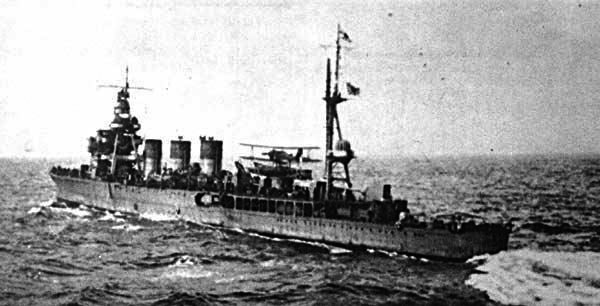
Abukuma_c1941
Abukuma (阿武隈) was built at the Uraga Dock, laid down on 8 December 1921, launched on 16 March 1923, commissioned on 26 May 1925, the last of the class by far. Commission indeed was delayed due to the Great Kantō earthquake. From November 1927 her fist active captain was Teijirō Toyoda. She was first commanded by Tokuda Inosuke as Chief Equipping Officer, then CO, the replaced by Otani Shiro, and Nagai Minoru.
Interwar service:
On 20 October 1930, she had an accident during a large-scale fleet maneuver: She rammed the cruiser Kitakami, stricken her between her No.2 and No.3 funnels. However damage was moderate on Kitakami while Abukuma had her bow smashed and was unable to continue steaming, due to the risk of flooding by the bow. She was towed by the IJN Mutsu to Tateyama in Chiba prefecture, and then headed for Yokosuka Naval Arsenal, still towed, but by tugboats. She was first repaired with a temporary bow on 22 November 1930, and headed for Kure naval arsenal to have her permament bow, slightly different than other ships as design progressed in between. Sendai cruisers, the last of the 1920s “classics” and “four pipers” indeed all had a slightly different designed bow, still with icebreaking features under the waterline, but a clipper end for better seakeeping. Abukuma had the same. Work ended on 30 December 1931 and until November 1932, she served under Captain Seiichi Iwamura.
In 1932, she was assigned to the Third Fleet, sent patrolling off the coast of northern China, after the Manchurian Incident (Marco Polo bridge). From 1933 and 1938 she received several upgrades. Her most famous interwar captain was between november 1934 and November 1935, Takeo Kurita.
IJN Abukuma then was assigned to convoy escort duties like her sister ships, notably committed during the Battle of Shanghai in 1937. She also assisted troops by providing gunfire. She remained on station and resumed patrols along the coast, also making incursions in the Yangtze River, deep enough thanks to her shallow draft. It went on throughout 1938.
WW2 Operations:
IJn Abukuma was ordered to Hitokappu Bay, and then to Etorofu in the Kurile Islands, on 26 November 1941. Under overall command of Nagumo’s Carrier Striking Force she was flagship, Rear Admiral Sentarō Ōmori DesRon1 (Shiranui, Arare, Kagerō, Kasumi, Tanikaze, Hamakaze, Isokaze, Urakaze) tasked of anti-submarine escort for the Kiduo Butai for the attack of Pearl Harbor. Afterwards, IJN Abukuma returned to Japan and a a hero’s welcome, on 23 December.
By January 1942, DesRon1 escorted the invasion force to Rabaul in New Britain and Kavieng in New Ireland, and afterwards joined her new operating base, Truk. By February, DesRon1 screen the Kido Butai when trying to catch Halsey TF 8 (USS Enterprise) after the raid on Kwajalein and Wotje (Marshalls). IJN Abukuma then escorted to Palau the Carrier Striking Force, and from there, screen the carriers into their raid on Port Darwin, Australia.
Late February and April saw DesRon1 supporting the raids on Java, the the Idian Ocean operations against Colombo and Trincomalee, seeing the destruction of HMS Hermes and two cruisers. They were based at Singapore from 11 April. But in May she was ordered north (Northern Force, Admiral Boshirō Hosogaya) as escort to IJN Ryūjō and Jun’yō, for the Attu and Kiska landings, which developed into the Battle of the Aleutian Islands.
Aleutian Operations:
This summer, DesRon1 was back to Japan, escorting a convoy of reinforcements for the Aleutians. Patrolling Aleutian and Kurile waters aside, DesRon1 escorted three more convoys in the Aleutians until December 1942. Back to Sasebo for a refit (12 December) which spanned until January, the cruiser sailed again northwards, in escort of more convoys to Attu and Kiska, one in January, one in February and one in March 1943. Then she took part at this occasion to the Battle of the Komandorski Islands, on 26 March 1943. She had the occasion of firing 95 rounds and four torpedoes but remained undamaged, but she assisted Nachi, badly damaged. This battle was a US tactical vistory (paid cash) in denying the Fifth Fleet to reinforce the Aleutians. Vice Admiral Hosogaya was disgraced after his withdrawal.
In April-May 1943, IJN Abukuma was in refit at Maizuru noyably fitted with an arir-surveillance radar) and thus missed “Operation Landcrab”, the US recapture of Attu. By July 1943 Abukuma led DesRon1 again in support, but this time for the evacuation of Kiska. On 26 July she collided with the frighter kaibokan Kunashiri, her starboard quarter was buckled inwards but nothing more. On 12 September she was sailing off Paramushiro when attacked by B-24 and B-25 Mitchell bombers, but just near-missed. In drydock at Yokosuka in October-November 1943 she was futher modernized and sent afterwards to patrol in December Hokkaidō and the Kurile islands, making ASW sorties for six months, until June.
Philippines Campaign:
From 21 June 1944 she underwent a last modernization at Yokosuka, until 13 July 1944, making her a specialized AA cruiser. She missed therefore the Battle of the Philippines sea, and remained in home waters until mid-October 1944, reassigned to operate a raid against a US fleet located off Taiwan, and re-directed from Mako to Manila, reporting to Vice Admiral Shoji Nishimura. IJN Abukuma made a decisive sortie with Nachi, Ashigara her destroyers under Vice Admiral Kiyohide Shima, which was caught underway on 15–22 October by six different US subs.
Only one was in a good position to fire, USS Seadragon. The flotilla was caught at 19 knots, zigzagging in the Luzon Strait on 22 October, and Seadragon missed. However soon the situation evolved and Abukuma was part of the Battle of Surigao Strait (Battle of Leyte Gulf), on 25 October 1944, pre-dawn, Shima’s force entered the strait, and Abukuma’s screening flotilla was immediately attacked by a squadron of American PT boats. PT-137 at 03:25 fired on a destroyer but the torpedo passed under, to strike IJN Abukuma behind. The torpedo struck No. 1 boiler room, killing 37 and she was disabled enough to fell behind. Emergency repairs allowed her to be underway again at 20 knots at 04:45 but she missed the action. At 05:35, she met the flotilla, but heavily flooded, down at the bow, Shima ordered her to retire at 08:30 for repairs in Dapitan, escorted by Ushio.
On 26 October, after superficial repairs at Dapitan she headed for Coron in Palawan, when spotted, and attacked by B-24 Liberator (5th Group, 13th AF). 500 lb (227 kg) bombs rained and she only experienced near-misses until at 10:06, she took a direct hit. The bomb struck near No.3 main Gun Mount, followed by two more at 10:20 (second wave, 33rd Sqn, 22nd Gpe, 5th AF). Her entire aft section was in fire, spreading to the engine rooms and aft torpedo rooms. Speed decreased until she was almost dead in the water. As fire rages at 10:37, four Type 93 “Long Lance” torpedoes exploded, breaking the ship aft sectin, making the captain ordering to abandon ship immediately. This started at 12:00 and was over at 12:30, off Negros Island. At 12:42, she sank by the stern, still with 250 men onboard, Ushio rescuing the captain and 283 crewmen. She was stricken on 20 December 1944.





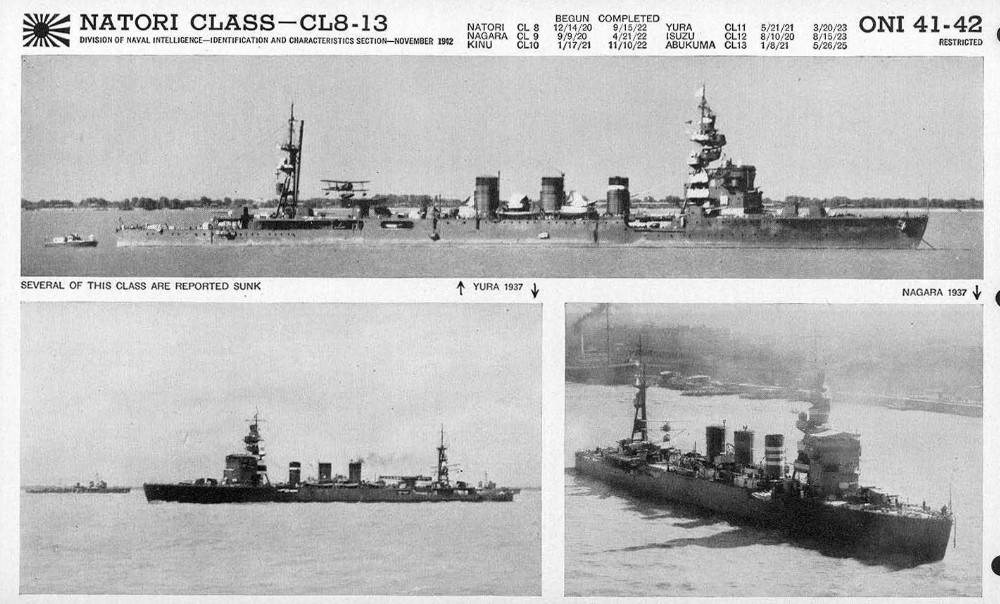
 Latest Facebook Entry -
Latest Facebook Entry -  X(Tweeter) Naval Encyclopedia's deck archive
X(Tweeter) Naval Encyclopedia's deck archive Instagram (@navalencyc)
Instagram (@navalencyc)





 French Navy
French Navy Royal Navy
Royal Navy Russian Navy
Russian Navy Armada Espanola
Armada Espanola Austrian Navy
Austrian Navy K.u.K. Kriegsmarine
K.u.K. Kriegsmarine Dansk Marine
Dansk Marine Nautiko Hellenon
Nautiko Hellenon Koninklije Marine 1870
Koninklije Marine 1870 Marinha do Brasil
Marinha do Brasil Osmanlı Donanması
Osmanlı Donanması Marina Do Peru
Marina Do Peru Marinha do Portugal
Marinha do Portugal Regia Marina 1870
Regia Marina 1870 Nihhon Kaigun 1870
Nihhon Kaigun 1870 Preußische Marine 1870
Preußische Marine 1870 Russkiy Flot 1870
Russkiy Flot 1870 Svenska marinen
Svenska marinen Søværnet
Søværnet Union Navy
Union Navy Confederate Navy
Confederate Navy Armada de Argentina
Armada de Argentina Imperial Chinese Navy
Imperial Chinese Navy Marinha do Portugal
Marinha do Portugal Mexico
Mexico Kaiserliche Marine
Kaiserliche Marine 1898 US Navy
1898 US Navy Sovietskiy Flot
Sovietskiy Flot Royal Canadian Navy
Royal Canadian Navy Royal Australian Navy
Royal Australian Navy RNZN Fleet
RNZN Fleet Chinese Navy 1937
Chinese Navy 1937 Kriegsmarine
Kriegsmarine Chilean Navy
Chilean Navy Danish Navy
Danish Navy Finnish Navy
Finnish Navy Hellenic Navy
Hellenic Navy Polish Navy
Polish Navy Romanian Navy
Romanian Navy Turkish Navy
Turkish Navy Royal Yugoslav Navy
Royal Yugoslav Navy Royal Thai Navy
Royal Thai Navy Minor Navies
Minor Navies Albania
Albania Austria
Austria Belgium
Belgium Columbia
Columbia Costa Rica
Costa Rica Cuba
Cuba Czechoslovakia
Czechoslovakia Dominican Republic
Dominican Republic Haiti
Haiti Hungary
Hungary Honduras
Honduras Estonia
Estonia Iceland
Iceland Eire
Eire Equador
Equador Iran
Iran Iraq
Iraq Latvia
Latvia Liberia
Liberia Lithuania
Lithuania Mandchukuo
Mandchukuo Morocco
Morocco Nicaragua
Nicaragua Persia
Persia San Salvador
San Salvador Sarawak
Sarawak Uruguay
Uruguay Venezuela
Venezuela Zanzibar
Zanzibar Warsaw Pact Navies
Warsaw Pact Navies Bulgaria
Bulgaria Hungary
Hungary

 Bundesmarine
Bundesmarine Dutch Navy
Dutch Navy Hellenic Navy
Hellenic Navy Marina Militare
Marina Militare Yugoslav Navy
Yugoslav Navy Chinese Navy
Chinese Navy Indian Navy
Indian Navy Indonesian Navy
Indonesian Navy JMSDF
JMSDF North Korean Navy
North Korean Navy Pakistani Navy
Pakistani Navy Philippines Navy
Philippines Navy ROKN
ROKN Rep. of Singapore Navy
Rep. of Singapore Navy Taiwanese Navy
Taiwanese Navy IDF Navy
IDF Navy Saudi Navy
Saudi Navy Royal New Zealand Navy
Royal New Zealand Navy Egyptian Navy
Egyptian Navy South African Navy
South African Navy






























 Ukrainian Navy
Ukrainian Navy dbodesign
dbodesign